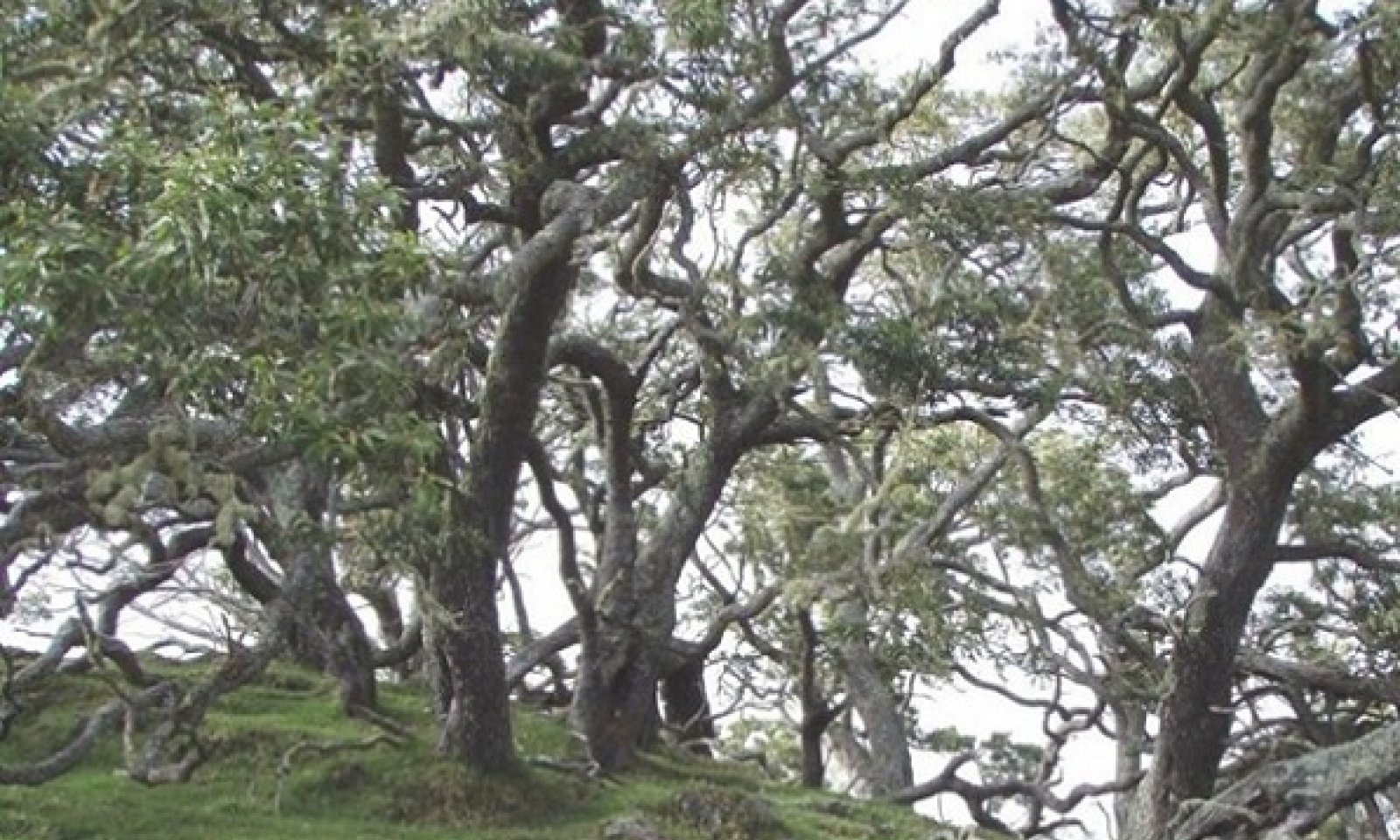

Natural Resources
Conservation Service
Ecological site VX160X01X502
Isomesic-Cool Isothermic Forest
Last updated: 4/17/2025
Accessed: 12/21/2025
General information
Provisional. A provisional ecological site description has undergone quality control and quality assurance review. It contains a working state and transition model and enough information to identify the ecological site.
MLRA notes
Major Land Resource Area (MLRA): 160X–Subhumid and Humid Intermediate and High Mountain Slopes
This MLRA occurs in the State of Hawaii on the Big Island of Hawaii and to a small extent on Maui. Elevation ranges from 1000 to 9000 feet (300 to 2725 meters). Slopes are moderate to steep. Topography is sloping to hilly, and cinder cones are common. Lava flows are basaltic or andesitic aa or pahoehoe lava. Aa may form outcrops at higher elevations, but most of the area is covered with material weathered from deep volcanic ash. Areas of volcanic sand and gravel alluvium exist. Average annual precipitation ranges from 20 to 75 inches (500 to 1875 millimeters). Most of the rainfall occurs during kona storms from November through March. In some areas afternoon fog accumulation at higher elevations adds significant moisture to the soil by fog drip and also ameliorates evapotranspiration. Average annual air temperatures range from 50 to 71 degrees F (10 to 20 degrees C), with little seasonal variation. Strong winds are frequent in the saddle between Mauna Kea and Kohala volcanoes. The dominant soil order is Andisols with an isomesic soil temperature regime and ustic or udic soil moisture regime. Native vegetation consists of forests and rangelands that can include medium to tall statured forests, savannas, and grasslands.
Classification relationships
This ecological site occurs within Major Land Resource Area (MLRA) 160 - Subhumid and Humid Intermediate and High Mountain Slopes.
Ecological site concept
This ecological site is the koa/mamani (syn. mamane) forest that occurs on the mauka slopes of Mauna Kea, except for the south and southwest aspects, and on the west and south aspects of Haleakala. It occurs on State lands, State Division of Hawaiian Homelands parcels, some Federal land, and private ranches. On Hawaii it is accessible along Mana Road from Waimea and along dirt roads off Observatory Road from Puuhuluhulu. On Maui, Haleakala Crater Road and Waipoli Road both cut through this ecological site on the west face of the mountain; access on the south face is limited. Most of this ecological site is open grassland used for livestock grazing. The original native forest has been reduced to remnants, especially on Maui.
The central concept of the Isomesic-Cool Isothermic Forest is of well drained, deep to very deep Andisols formed in deposits of volcanic ash ranging from 11,000 to 980,000 years old. Annual air temperatures and rainfall are associated with cool (isomesic to the cooler range of isothermic), seasonally dry (ustic to the drier range of udic) soil conditions. The tall tree overstory consists of koa (Acacia koa) and ohia lehua (Metrosideros polymorpha). The secondary tree overstory contains species that would form the overstory in drier forest types, such as mamane (Sophora chrysophylla), naio (Myoporum sandwicense), sandalwood (Santalum paniculatum on Hawaii, S. haleakalae on Maui), akoko or alpine sandmat (Euphorbia olowaluana syn. Chamaesyce olowaluana), mountain pilo (Coprosma montana), and kolea (Myrsine lanaiensis). Many species of native shrubs, vines, forbs, ferns, grasses, and sedges occur in this ecological site.
Associated sites
| VX159A01X500 |
Well Drained Udic and Perudic Forest F159AY500 Well Drained Udic and Perudic Forest is tall stature rain forest dominated by koa, ohia lehua, and hapuu bordering F160XY502 at lower elevations. |
|---|
Similar sites
| VX161B01X503 |
Ustic Isomesic Forest F161BY503 Ustic Isomesic Forest is similar in plant species composition to F160XY502. F161BY503 is on Mauna Loa and Hualalai; soils are younger and often with organic rather than mineral parent materials. |
|---|
Table 1. Dominant plant species
| Tree |
(1) Acacia koa |
|---|---|
| Shrub |
(1) Osteomeles anthyllidifolia |
| Herbaceous |
(1) Dubautia arborea |
Legacy ID
F160XY502HI
Physiographic features
This ecological site occurs on volcanic ash fields over lava flows on sloping mountainsides of shield volcanoes. Lava flows are aa (loose, cobbly) or pahoehoe (smooth, relatively unbroken). Volcanic ash fields range from moderately deep to deep on the underlying lava.
Table 2. Representative physiographic features
| Landforms |
(1)
Shield volcano
> Ash field
(2) Shield volcano > Aa lava flow |
|---|---|
| Runoff class | Low to medium |
| Flooding frequency | None |
| Ponding frequency | None |
| Elevation | 4,000 – 8,000 ft |
| Slope | 50% |
| Water table depth | 60 in |
| Aspect | NW, N, NE, E, SE |
Table 3. Representative physiographic features (actual ranges)
| Runoff class | Very low to very high |
|---|---|
| Flooding frequency | None |
| Ponding frequency | None |
| Elevation | 3,608 – 9,594 ft |
| Slope | 70% |
| Water table depth | 60 in |
Climatic features
Summary for this ecological site
In this ecological site, average annual precipitation ranges from 40 to 60 inches (1000 to 1500 millimeters). Most precipitation falls from October through April. Average annual air temperature ranges from 53 to 60 degrees F (12 to 16 degrees C).
Some of the soils correlated with this ecological site extend into zones with rainfall as low as 20 inches (500 millimeters) and as high as 80 inches (2000 millimeters); these areas are transitional to other ecological sites.
General climate principles for Hawaii
Air temperature in Hawaii is buffered by the surrounding ocean so that the range in temperature through the year is narrow. This creates “iso-“soil temperature regimes in which mean summer and winter temperatures differ by less than 11 degrees F (6 degrees C).
Hawaii lies within the trade wind zone. Significant amounts of moisture are picked up from the ocean by trade winds up to an altitude of more than 6000 feet (very roughly 2000 meters). As the trade winds from the northeast are forced up the mountains of the island their moisture condenses, creating rain on the windward slopes; the leeward side of the island receives little of this moisture. At approximately 6000 feet elevation there is a temperature inversion at the boundary between moist air and higher, drier air. Above the inversion layer, average annual temperatures decrease at a slower rate than below it and average annual precipitation decreases abruptly. Easily observed vegetation changes occur within a short distance at the inversion layer.
On the windward side of the island, cool, moist air at higher elevations descends toward the ocean where it meets the trade winds; this process brings night-time rainfall to lower elevation areas.
In winter, low pressure systems often approach the island from the west, producing extensive rainstorms that primarily affect the leeward sides of the island.
Reference: Giambelluca and Schroeder 1998.
Table 4. Representative climatic features
| Frost-free period (characteristic range) | 365 days |
|---|---|
| Freeze-free period (characteristic range) | 365 days |
| Precipitation total (characteristic range) | 40-60 in |
| Frost-free period (actual range) | 365 days |
| Freeze-free period (actual range) | 365 days |
| Precipitation total (actual range) | 20-80 in |
| Frost-free period (average) | 365 days |
| Freeze-free period (average) | 365 days |
| Precipitation total (average) | 50 in |
Figure 1. Monthly precipitation range
Figure 2. Monthly minimum temperature range
Figure 3. Monthly maximum temperature range
Figure 4. Monthly average minimum and maximum temperature
Figure 5. Annual precipitation pattern
Figure 6. Annual average temperature pattern
Climate stations used
-
(1) HALEAKALA RS 338 [USC00511004], Kula, HI
Influencing water features
There are ephemeral or seasonal streams carrying water from areas mauka (above) this ecological site that have formed gulches. The gulches are vegetated with species typical of the rest of the ecological site. Some of these gulches still support an exceptionally high diversity of native species including those found in the Pu'u pahu reserve on Maui.
Soil features
Typical soils in this ecological site formed in deep to very deep, rapidly weathered volcanic ash deposited on aa or pahoehoe. Soil temperature regimes are cool isothermic to isomesic. Soil moisture regimes are ustic (soil moisture control section is dry in some or all parts for 90 or more cumulative days in normal years) to the dry range of udic (in most years, not dry for as long as 90 cumulative days).
The volcanic ash soils of the Island of Hawaii are derived mostly from basaltic ash that varies relatively little in chemical composition (Hazlett and Hyndman 1996; Vitousek 2004)). Most of these volcanic ash soils are classified as Andisols, which have these general management characteristics: ion exchange capacity that varies with pH, but mostly retaining anions such as nitrate; high phosphorus adsorption, which restricts phosphorus availability to plants; excellent physical properties (low bulk density, good friability, weak stickiness, stable soil aggregates) for cultivation, seedling emergence, and plant root growth; resistance to compaction and an ability to recover from compaction following repeated cycles of wetting and drying; and high capacity to hold water that is available to plants. These characteristics are due to the properties of the parent material, the clay-size noncrystalline materials formed by weathering, and the soil organic matter accumulated during soil formation (Shoji et al. 1993).
Soils in the UMA series occur on cinder cones on Maui. They have a surface layer of loamy coarse sand that overlies black cinders. Roots are abundant from 0 to 6 inches (15 centimeters) deep and few from 6 to 55 inches (15 to 138 centimeters) deep. They currently support mostly introduced tree species. Areas on Mauna Kea at the highest elevation range of koa and on black cinder cones support large koa trees.
Table 5. Representative soil features
| Parent material |
(1)
Basic volcanic ash
–
basalt
|
|---|---|
| Surface texture |
(1) Medial loam (2) Medial fine sandy loam |
| Family particle size |
(1) Loamy |
| Drainage class | Well drained |
| Permeability class | Moderately rapid to rapid |
| Soil depth | 50 – 62 in |
| Surface fragment cover <=3" | 5 – 45% |
| Surface fragment cover >3" | 40% |
| Available water capacity (0-40in) |
50 in |
| Calcium carbonate equivalent (0-40in) |
Not specified |
| Electrical conductivity (0-40in) |
2 mmhos/cm |
| Sodium adsorption ratio (0-40in) |
Not specified |
| Soil reaction (1:1 water) (0-40in) |
5.4 – 7.8 |
| Subsurface fragment volume <=3" (Depth not specified) |
5 – 25% |
| Subsurface fragment volume >3" (Depth not specified) |
40% |
Table 6. Representative soil features (actual values)
| Drainage class | Well drained to somewhat excessively drained |
|---|---|
| Permeability class | Very slow to rapid |
| Soil depth | 5 – 72 in |
| Surface fragment cover <=3" | 5 – 45% |
| Surface fragment cover >3" | 40% |
| Available water capacity (0-40in) |
50 in |
| Calcium carbonate equivalent (0-40in) |
5% |
| Electrical conductivity (0-40in) |
5 mmhos/cm |
| Sodium adsorption ratio (0-40in) |
15 |
| Soil reaction (1:1 water) (0-40in) |
4.5 – 9 |
| Subsurface fragment volume <=3" (Depth not specified) |
40% |
| Subsurface fragment volume >3" (Depth not specified) |
40% |
Ecological dynamics
The information in this ecological site description (ESD), including the state-and-transition model (STM), was developed using archaeological and historical data, professional experience, and scientific studies. The information is representative of a complex set of plant communities. Not all scenarios or plants are included. Key indicator plants, animals, and ecological processes are described to inform land management decisions.
This ecological site is currently a patchwork of naturalized species that reflect primarily grassland but also forest depending on the pattern of disturbance and/or management. The primary land use at this time is grazing land and these grasslands consist of Kikuyugrass and some C3 pasture grasses which are naturalized to the site.
The Reference State for this ecological site is a dry to semi mesic tropical forest consisting of an overstory of koa (Acacia koa) and ohia lehua (Metrosideros polymorpha), a mid-story of small to medium sized native trees and shrubs, and an understory of native vines, forbs, ferns, grasses and sedges. The original native forest state has been reduced to remnants, especially on Maui. Most of this ecological site has been converted to a naturalized grassland state (with or without a remnant open canopy of native trees). Dense Koa forest states exist (with or without native tree remnants) within select areas of this ecological site. These koa forests either re-sprouted naturally from seed, were intentionally planted, or have been encouraged by ground scarification actions which stimulated the seedbank. This restored koa state may be intended for eventual harvest, an intermediate step to restoration to the Reference State, or for silvopasture. This ecological site also supports a state dominated by either introduced trees, or by introduced shrubs. Black wattle (Acacia mearnsii), is an extremely fast-growing invasive tree currently choking pastures, gulches, and empty lots across 3,000 acres upcountry on Maui, and to a much lesser extent on Hawaii. Faya tree (Morella faya) is another problematic introduced tree which is capable of forming dense, single-species stands, devoid of other plant life. Introduced plantations of blue gum eucalyptus (Eucalyptus globulus) and conifer plantations also occur in select areas in this ecological site (mostly on Maui). The blue gum ecucalyptus stands are currently experiencing a massive die off as a result of an invasive beetle infestation; creating both hazardous vegetation issues and reclamation opportunities. Gorse (Ulex europaeus), an invasive shrub, was introduced intentionally to this ecological site early in the 20th century to function as a living fence. This invasive shrub has since expanded its range and density considerably and now forms a monoculture on large acreages, primarily on Mauna Kea but also on large areas of Haleakala.
Natural Disturbances
There have been no lava flows or heavy volcanic ash flows on this ecological site that are recent enough to have affected the current vegetation and soils. It is possible that strong storms may sometimes cause windthrow of trees. Wildfires started by lightning sometimes affect this ecological site.
Human Disturbances
Human-related disturbances have been much more important than natural disturbances in this ecological site since the arrival of Polynesians and, later, Europeans. This is reflected in the State and Transition Model Diagram.
Humans arrived in the Hawaiian Islands 1200 to 1500 years ago. Their population gradually increased so that by 1600 AD at least 80% of all the lands in Hawaii below about 1500 feet (roughly 500 meters) in elevation had been extensively altered by humans (Kirch 1982); some pollen core data suggest that up to 100% of lowlands may have been altered (Athens 1997). By the time of European contact late in the 18th century, the Polynesians had developed high population densities and placed extensive areas under intensive agriculture (Cuddihy and Stone 1990).
Prehistoric native lowland forest disturbance can be attributed to clearing for agriculture by hand or by fire, introduction of new plants and animals, and wood harvesting. Higher elevation forests, such as this ecological site, would have been much less affected, but may have been affected by factors such as inadvertently introduced plant diseases and seed predation by the introduced Pacific rat (Athens 1997).
After the arrival of Europeans, documentary evidence attests to accelerated and extensive deforestation, erosion, siltation, and changes in local weather patterns (Kirch 1983) due to more intensive land use, modern tools, and introduction of more plant, animal, and microbe species.
The Polynesians introduced dogs, Pacific rats, and small pigs to the islands. Cattle, sheep, horses, goats, and larger European pigs were introduced in the final decades of the 18th century. These animals ranged free on the islands, becoming very numerous and destructive by the early decades of the 19th century. Additionally, packs of feral dogs had become established, as confirmed by reports of their depredations on sheep. By 1851, records reported severe overstocking of pastures, lack of fences, and large numbers of feral livestock (Henke 1929).
Through the 20th and into the 21st centuries, increases in human populations with attendant land development, as well as accelerated introduction of non-native mammals, birds, reptiles, amphibians, invertebrates, plants, and microorganisms, have brought about dramatic changes to wild ecosystems in Hawaii. Much of the original forest of this ecological site has been cleared and planted with introduced grasses for livestock grazing, and the remaining native plant stands have been highly disturbed.
Most of the mountain sandalwood (Santalum paniculatum on Hawaii, S. haleakalae on Maui) was cut from this ecological site forests and shipped to China in the early 1800s. Most of the sandalwood had been harvested by the 1840s.
By the second quarter of the 19th Century, immense herds of livestock were present in the area. Throughout the middle and late 1800s, efforts at control of the introduced herbivores continued, but with only minimal success (Henke 1929). Currently, areas used by domestic livestock are fenced and managed for forage grasses.
A series of large wildfires swept through this ecological site in the early 20th century. These fires probably were carried by introduced grasses that had been established in the area. In 2021 a wildfire on Hawaii's Big Island has burned more than 40,000 acres brush and grass in the south Kohala area.
State and transition model
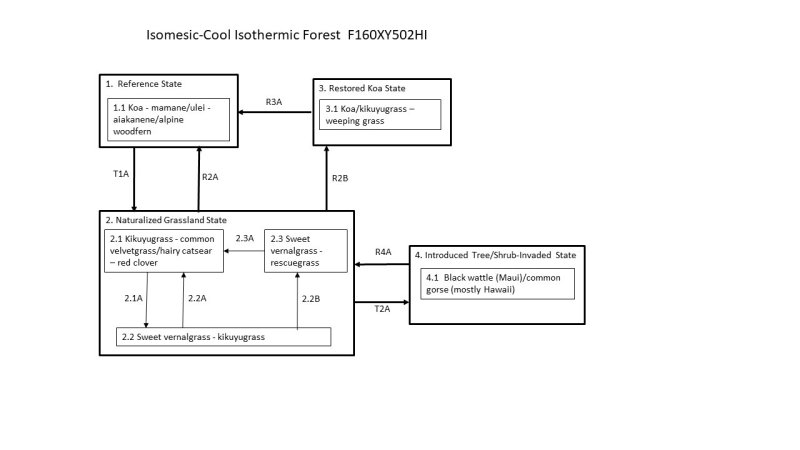
Figure 7. STM F160XY502HI
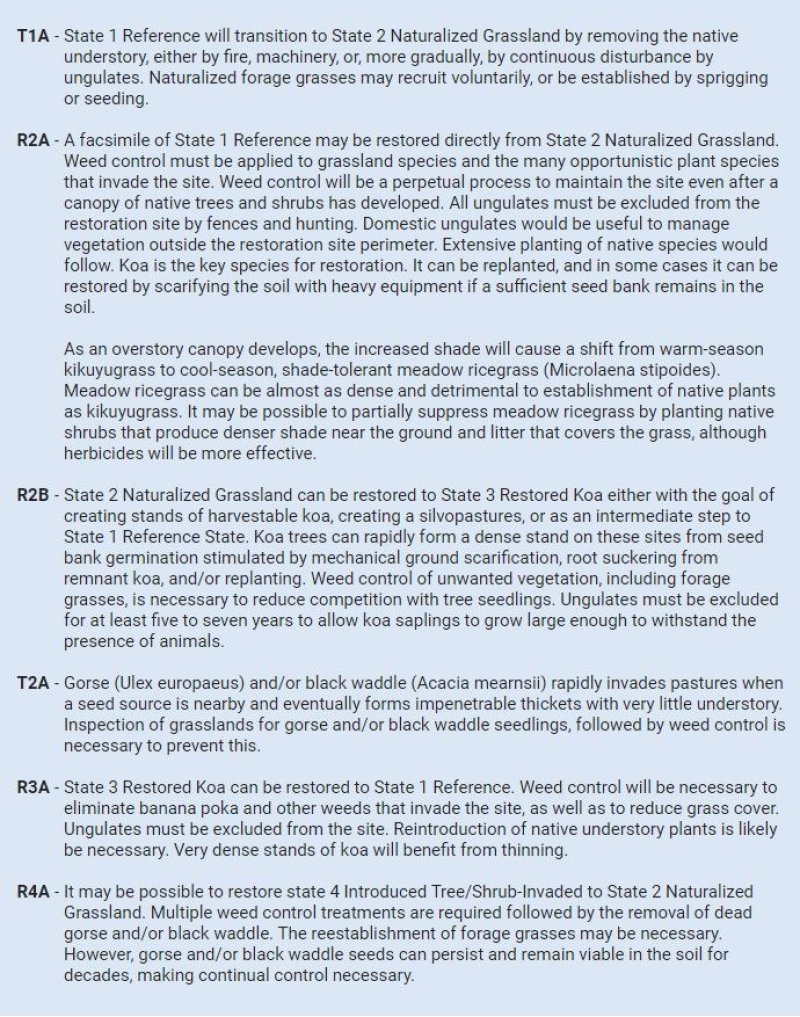
Figure 8. Transitions and Restoration Pathways F160XY502HI
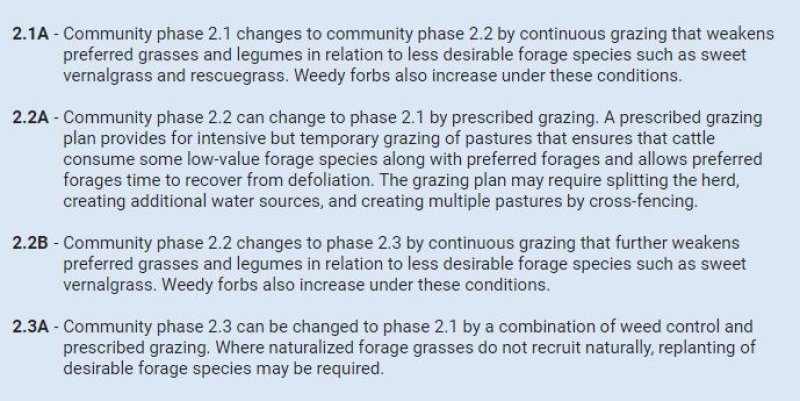
Figure 9. Community Pathways F160XY502HI
More interactive model formats are also available.
View Interactive Models
More interactive model formats are also available.
View Interactive Models
Click on state and transition labels to scroll to the respective text
Ecosystem states
| T1A | - | State 1 Reference will transition to State 2 Naturalized Grassland by removing the native understory, either by fire, machinery, or, more gradually, by continuous disturbance by ungulates. Naturalized forage grasses may recruit voluntarily, or be established by sprigging or seeding. |
|---|---|---|
| R2A | - | A facsimile of State 1 Reference may be restored directly from State 2 Naturalized Grassland. Weed control must be applied to grassland species and the many opportunistic plant species that invade the site. Weed control will be a perpetual process to maintain the site even after a canopy of native trees and shrubs has developed. All ungulates must be excluded from the restoration site by fences and hunting. Domestic ungulates would be useful to manage vegetation outside the restoration site perimeter. Extensive planting of native species would follow. Koa is the key species for restoration. It can be replanted, and in some cases it can be restored by scarifying the soil with heavy equipment if a sufficient seed bank remains in the soil. As an overstory canopy develops, the increased shade will cause a shift from warm-season kikuyugrass to cool-season, shade-tolerant meadow ricegrass (Microlaena stipoides). Meadow ricegrass can be almost as dense and detrimental to establishment of native plants as kikuyugrass. It may be possible to partially suppress meadow ricegrass by planting native shrubs that produce denser shade near the ground and litter that covers the grass, although herbicides will be more effective. |
| R2B | - | State 2 Naturalized Grassland can be restored to State 3 Restored Koa either with the goal of creating stands of harvestable koa, creating a silvopastures, or as an intermediate step to State 1 Reference State. Koa trees can rapidly form a dense stand on these sites from seed bank germination stimulated by mechanical ground scarification, root suckering from remnant koa, and/or replanting. Weed control of unwanted vegetation, including forage grasses, is necessary to reduce competition with tree seedlings. Ungulates must be excluded for at least five to seven years to allow koa saplings to grow large enough to withstand the presence of animals. |
| T2A | - | Gorse (Ulex europaeus) and/or black waddle (Acacia mearnsii) rapidly invades pastures when a seed source is nearby and eventually forms impenetrable thickets with very little understory. Inspection of grasslands for gorse and/or black waddle seedlings, followed by weed control is necessary to prevent this. |
| R3A | - | State 3 Restored Koa can be restored to State 1 Reference. Weed control will be necessary to eliminate banana poka and other weeds that invade the site, as well as to reduce grass cover. Ungulates must be excluded from the site. Reintroduction of native understory plants is likely be necessary. Very dense stands of koa will benefit from thinning. |
| R4A | - | It may be possible to restore state 4 Introduced Tree/Shrub-Invaded to State 2 Naturalized Grassland. Multiple weed control treatments are required followed by the removal of dead gorse and/or black waddle. The reestablishment of forage grasses may be necessary. However, gorse and/or black waddle seeds can persist and remain viable in the soil for decades, making continual control necessary. |
State 1 submodel, plant communities
State 2 submodel, plant communities
| 2.1A | - | Community phase 2.1 changes to community phase 2.2 by continuous grazing that weakens preferred grasses and legumes in relation to less desirable forage species such as sweet vernalgrass and rescuegrass. Weedy forbs also increase under these conditions. |
|---|---|---|
| 2.2A | - | Community phase 2.2 can change to phase 2.1 by prescribed grazing. A prescribed grazing plan provides for intensive but temporary grazing of pastures that ensures that cattle consume some low-value forage species along with preferred forages and allows preferred forages time to recover from defoliation. The grazing plan may require splitting the herd, creating additional water sources, and creating multiple pastures by cross-fencing. |
| 2.2B | - | Community phase 2.2 changes to phase 2.3 by continuous grazing that further weakens preferred grasses and legumes in relation to less desirable forage species such as sweet vernalgrass. Weedy forbs also increase under these conditions. |
| 2.3A | - | Community phase 2.3 can be changed to phase 2.1 by a combination of weed control and prescribed grazing. Where naturalized forage grasses do not recruit naturally, replanting of desirable forage species may be required. |
State 3 submodel, plant communities
State 4 submodel, plant communities
State 1
Reference State
This state consists of one community phase. Intact examples of this community phase no longer exist. Most of the forested areas have transitioned to State 2 Naturalized Grassland through mechanical clearing, long-term grazing, browsing, and trampling by ungulates, wood harvesting, competition from introduced plant species, and wildfires. In order to describe an approximation of the Reference State, it was necessary to use information collected from small stands, incomplete plant communities, and similar ecological sites on the island.
Community 1.1
Koa - mamane/`ulei - aiakanene/alpine woodfern

Figure 10. Reference community phase overstory. 6/25/08 D Clausnitzer generic photo
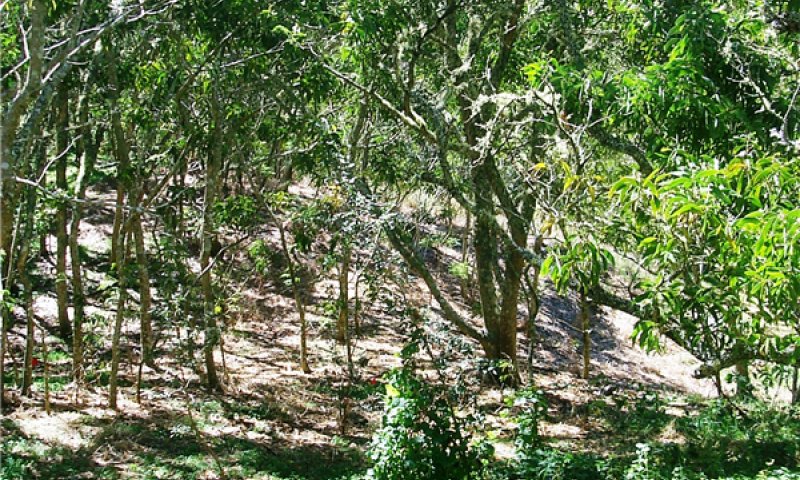
Figure 11. Midstory. 11/07/06 D Clausnitzer MU839
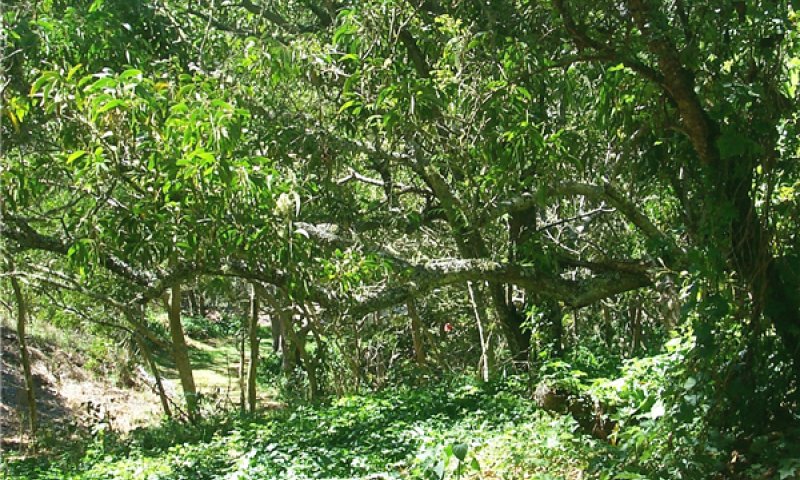
Figure 12. Understory. 11/07/06 D Clausnitzer MU839
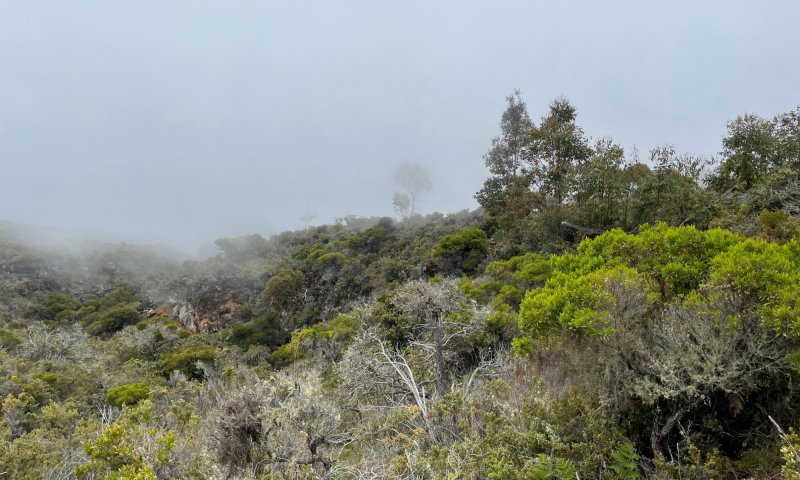
Figure 13. Pu’u Pahu is a native-dominated shrubland directly below the National Park, fenced to allow for natural recovery by excluding goats, pigs, and deer. Many species of native shrubs, vines, forbs, ferns, grasses, and sedges occur in this ecological site.
This is forest with an open or closed upper canopy of koa (Acacia koa) trees up to 80 feet (24 meters) tall, a secondary canopy of multiple species 20 to 50 feet tall, and an understory of shrubs, vines, grasses, and forbs. These forests typically have standing live timber of 1000 to 2500 cubic feet per acre, with a representative value of about 1700 cubic feet per acre. These estimates represent recent measurements of standing live trees that are probably lower than the amounts present in the original, undisturbed forests.
Forest overstory. The overstory consists of koa and some ohia lehua (Metrosideros polymorpha) up to 80 feet (24 meters) tall.
Forest understory. The understory consists of an intermediate canopy 20 to 50 feet (6 to 15 meters) tall of mountain sandalwood (Santalum paniculatum on Hawaii, S. haleakalae on Maui), naio (Myoporum sandwicense), mamane (Sophora chrysophylla), akoko or alpine sandmat (Euphorbia olowaluana syn. Chamaesyce olowaluana), mountain pilo or alpine mirrorplant (Coprosma montana), kolea or Lanai colicwood (Myrsine lanaiensis), kolea lau nui (Myrsine lessertiana), and hoawa or cheesewood (Pittosporum spp.). Just below this canopy are tree-form aalii (Dodonaea viscosa) and dubautia species (Dubautia spp.). The lowest levels of the forest include grass and grass-like species, forbs, fern and fern allies, shrubs, vines, and seedlings and saplings of the overstory species.
Dominant plant species
-
koa (Acacia koa), tree
-
mamani (Sophora chrysophylla), tree
-
'ohi'a lehua (Metrosideros polymorpha), tree
-
'aiakanene (Coprosma ernodeoides), shrub
-
Hawai'i hawthorn (Osteomeles anthyllidifolia), shrub
-
alpine woodfern (Dryopteris wallichiana), grass
Table 7. Soil surface cover
| Tree basal cover | 3-4% |
|---|---|
| Shrub/vine/liana basal cover | 1-2% |
| Grass/grasslike basal cover | 0.1-0.5% |
| Forb basal cover | 0.0-0.1% |
| Non-vascular plants | 0.5-1.0% |
| Biological crusts | 0.5-1.0% |
| Litter | 80-85% |
| Surface fragments >0.25" and <=3" | 0.5-1.0% |
| Surface fragments >3" | 0.5-1.0% |
| Bedrock | 0% |
| Water | 0% |
| Bare ground | 0.5-1.0% |
Table 8. Woody ground cover
| Downed wood, fine-small (<0.40" diameter; 1-hour fuels) | – |
|---|---|
| Downed wood, fine-medium (0.40-0.99" diameter; 10-hour fuels) | – |
| Downed wood, fine-large (1.00-2.99" diameter; 100-hour fuels) | – |
| Downed wood, coarse-small (3.00-8.99" diameter; 1,000-hour fuels) | 2-3% |
| Downed wood, coarse-large (>9.00" diameter; 10,000-hour fuels) | 1-1% |
| Tree snags** (hard***) | – |
| Tree snags** (soft***) | – |
| Tree snag count** (hard***) | 2-3 per acre |
| Tree snag count** (hard***) | 1-2 per acre |
* Decomposition Classes: N - no or little integration with the soil surface; I - partial to nearly full integration with the soil surface.
** >10.16cm diameter at 1.3716m above ground and >1.8288m height--if less diameter OR height use applicable down wood type; for pinyon and juniper, use 0.3048m above ground.
*** Hard - tree is dead with most or all of bark intact; Soft - most of bark has sloughed off.
Table 9. Canopy structure (% cover)
| Height Above Ground (ft) | Tree | Shrub/Vine | Grass/ Grasslike |
Forb |
|---|---|---|---|---|
| <0.5 | 0% | 0-1% | 1-1% | 1-1% |
| >0.5 <= 1 | 0% | 1-2% | 2-3% | 1-2% |
| >1 <= 2 | 0-1% | 5-7% | 1-2% | 2-3% |
| >2 <= 4.5 | 0-1% | 5-7% | – | 1-2% |
| >4.5 <= 13 | 5-10% | 5-7% | – | – |
| >13 <= 40 | 25-30% | – | – | – |
| >40 <= 80 | 35-40% | – | – | – |
| >80 <= 120 | 1-2% | – | – | – |
| >120 | – | – | – | – |
State 2
Naturalized Grassland State
This state is comprised of three community phases. They are naturalized grasslands that may have an open canopy of remnant native trees. Trees in these pastures provide shade and protection from the elements to livestock. Where shade is dense, the growth of a weedy cool-season grass species can be favored. Very little tree regeneration occurs, so trees eventually die out. Community phase 2.1 is dominated by warm-season (C4) kikuyugrass (Pennisetum clandestinum) with a small admixture of cool-season (C3) forage grasses. C3 forage grasses increase with increasing elevation and decreasing grazing pressure. Cool-season meadow ricegrass, a less desirable forage species, may be abundant in shady areas under trees. Continuous grazing that does not allow favored forage species time to recover from defoliation results in community phase 2.2, which is dominated by lower value forage species but contains enough desired forage grasses to change back to 2.1 with prescribed grazing. Further continuous grazing leads to community phase 2.3, which is dominated by undesirable grass species and weedy forbs.
Community 2.1
Kikuyugrass - common velvetgrass/hairy catsear - red clover

Figure 14. Kikuyu grassland with remnant native trees. 1/06/09 D Clausnitzer generic photo

Figure 15. Evidence of former koa forest. 7/18/08 D Clausnitzer generic photo
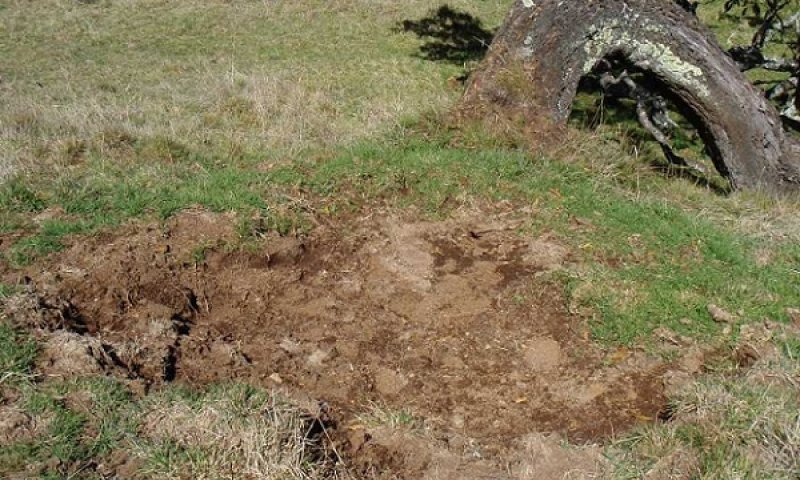
Figure 16. Pig damage to soil surface. 01/06/09 D Clausnitzer generic photo
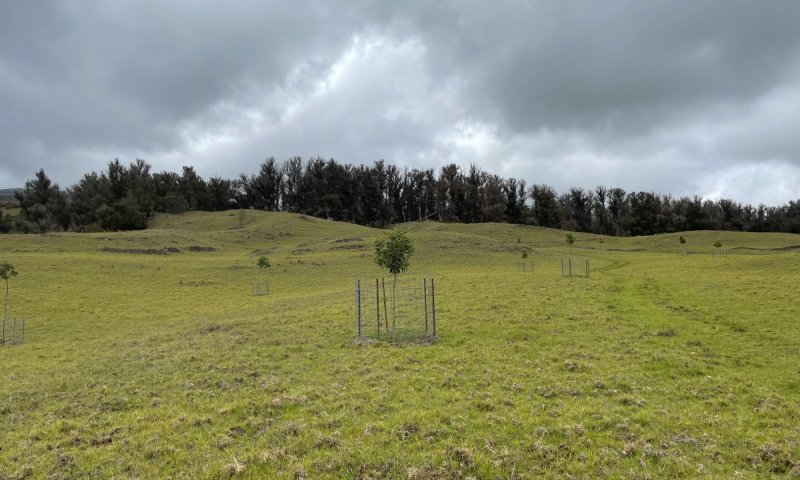
Figure 17. Kikuyu grassland with an early stage silvopasture of Koa. Koa plantings in this section were spaced at 50 foot increments. MU KDVE. 4,900 feet. John Proctor. 5/24/22
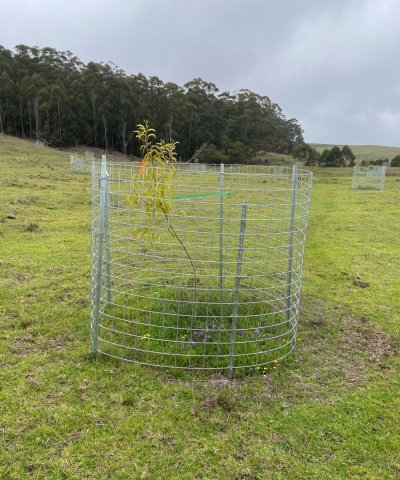
Figure 18. Kikuyu grassland with an early stage silvopasture of Koa. Concrete wire protects plantings. Flowering forbs were added to promote diversity and increase beneficial insects. MU KDVE. 4,900 feet. John Proctor. 5/24/22.
The dominant grass species is kikuyugrass. Some cool-season perennial forage grasses are present along with forage legumes. All of the grasses and forbs are introduced species. Native koa and mamani trees may be present.
Forest overstory. Native koa (Acacia koa) and mamane (Sophora chrysophylla) trees may be present, along with dead and downed trees.
Forest understory. Kikuyugrass is by far the most abundant and productive forage grass. Cool-season perennial forage grasses include common velvetgrass (Holcus lanatus), orchardgrass (Dactylis glomerata), perennial ryegrass (Lolium perenne), Italian ryegrass (Lolium multiflorum), and Kentucky bluegrass (Poa pratensis), and sweet vernalgrass (Anthoxanthum odoratum). Annual or short-lived perennial grasses, including tufted lovegrass (Eragrostis pectinacea), rescuegrass (Bromus catharticus), and brome fescue (Vulpia bromoides) are present. Three forage legumes, rabbitfoot clover (Trifolium arvense), red clover (Trifolium pretense), and white clover (Trifolium repens) are present in significant amounts.
Dominant plant species
-
kikuyugrass (Pennisetum clandestinum), grass
-
common velvetgrass (Holcus lanatus), grass
-
hairy cat's ear (Hypochaeris radicata), other herbaceous
-
red clover (Trifolium pratense), other herbaceous
Figure 19. Annual production by plant type (representative values) or group (midpoint values)
Community 2.2
Sweet vernalgrass - kikuyugrass
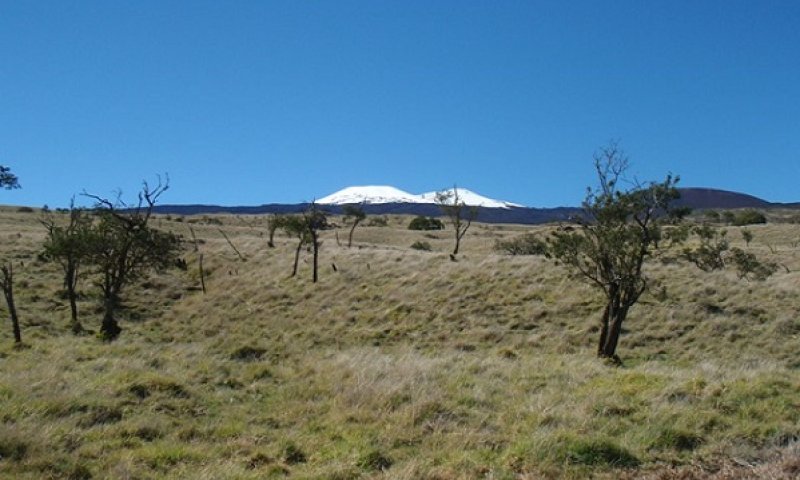
Figure 20. Sweet vernalgrass and kikuyugrass with remnant mamani. 01/06/09 D Clausnitzer generic photo
This community phase has significant cover of grasses of relatively low forage value such as sweet vernalgrass, as well as increased cover of weedy forbs. Desirable forage legumes have been grazed out. Native koa and/or mamani trees may be present.
Forest overstory. Native koa (Acacia koa) and mamani (Sophora chrysophylla) trees may be present, along with dead and downed trees.
Forest understory. Percent cover of kikuyugrass, common velvetgrass, and orchardgrass is still significant but much reduced from community phase 3.1. The most abundant grass is sweet vernalgrass, which is a less desirable forage. The three clover species present in phase 3.1 are no longer present. Cover of weedy forbs has increased to around 20 percent.
Dominant plant species
-
sweet vernalgrass (Anthoxanthum odoratum), grass
-
kikuyugrass (Pennisetum clandestinum), grass
Table 10. Soil surface cover
| Tree basal cover | 0.0-0.1% |
|---|---|
| Shrub/vine/liana basal cover | 0% |
| Grass/grasslike basal cover | 15-25% |
| Forb basal cover | 1-2% |
| Non-vascular plants | 0.1-1.0% |
| Biological crusts | 0.1-1.0% |
| Litter | 60-70% |
| Surface fragments >0.25" and <=3" | 0.5-1.0% |
| Surface fragments >3" | 0.5-1.0% |
| Bedrock | 0% |
| Water | 0% |
| Bare ground | 5-10% |
Table 11. Woody ground cover
| Downed wood, fine-small (<0.40" diameter; 1-hour fuels) | – |
|---|---|
| Downed wood, fine-medium (0.40-0.99" diameter; 10-hour fuels) | – |
| Downed wood, fine-large (1.00-2.99" diameter; 100-hour fuels) | – |
| Downed wood, coarse-small (3.00-8.99" diameter; 1,000-hour fuels) | – |
| Downed wood, coarse-large (>9.00" diameter; 10,000-hour fuels) | 0-1% |
| Tree snags** (hard***) | – |
| Tree snags** (soft***) | – |
| Tree snag count** (hard***) | |
| Tree snag count** (hard***) | 0 per acre |
* Decomposition Classes: N - no or little integration with the soil surface; I - partial to nearly full integration with the soil surface.
** >10.16cm diameter at 1.3716m above ground and >1.8288m height--if less diameter OR height use applicable down wood type; for pinyon and juniper, use 0.3048m above ground.
*** Hard - tree is dead with most or all of bark intact; Soft - most of bark has sloughed off.
Table 12. Canopy structure (% cover)
| Height Above Ground (ft) | Tree | Shrub/Vine | Grass/ Grasslike |
Forb |
|---|---|---|---|---|
| <0.5 | – | 0% | 0% | 0-1% |
| >0.5 <= 1 | – | 0% | 1-1% | 1-2% |
| >1 <= 2 | – | 1-1% | 80-90% | 15-25% |
| >2 <= 4.5 | – | 0% | 1-1% | 1-1% |
| >4.5 <= 13 | – | – | – | – |
| >13 <= 40 | 1-5% | – | – | – |
| >40 <= 80 | 1-25% | – | – | – |
| >80 <= 120 | – | – | – | – |
| >120 | – | – | – | – |
Community 2.3
Sweet vernalgrass - rescuegrass
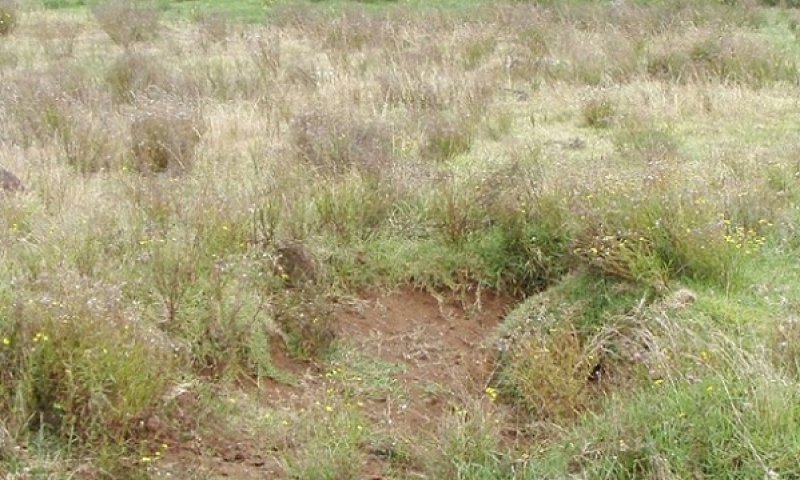
Figure 21. Degraded grassland. 07/18/08 D Clausnitzer generic photo
This community phase is dominated by undesirable grasses and weedy forbs. Abundance of desirable forages has declined to a level that requires more than just prescribed grazing to bring back high forage productivity.
Forest overstory. Native koa (Acacia koa) and mamani (Sophora chrysophylla) trees may be present, along with dead and downed trees.
Forest understory. Sweet vernalgrass is the most abundant grass species, and rescuegrass has increased to significant abundance. Common velvetgrass and orchardgrass are present but low in cover. Annual grasses and weedy forbs make up a large part of total plant cover. The extent of bare soil is around 20 percent.
Dominant plant species
-
sweet vernalgrass (Anthoxanthum odoratum), grass
-
rescuegrass (Bromus catharticus), grass
Table 13. Soil surface cover
| Tree basal cover | 0% |
|---|---|
| Shrub/vine/liana basal cover | 0% |
| Grass/grasslike basal cover | 25-30% |
| Forb basal cover | 3-5% |
| Non-vascular plants | 0.0-0.5% |
| Biological crusts | 0.0-0.5% |
| Litter | 50-60% |
| Surface fragments >0.25" and <=3" | 0.5-1.0% |
| Surface fragments >3" | 0.5-1.0% |
| Bedrock | 0% |
| Water | 0% |
| Bare ground | 10-20% |
Table 14. Canopy structure (% cover)
| Height Above Ground (ft) | Tree | Shrub/Vine | Grass/ Grasslike |
Forb |
|---|---|---|---|---|
| <0.5 | – | 0% | 1-2% | 0-1% |
| >0.5 <= 1 | – | 0% | 1-2% | 0-1% |
| >1 <= 2 | – | 0% | 60-70% | 40-50% |
| >2 <= 4.5 | – | 0% | 1-2% | 1-1% |
| >4.5 <= 13 | – | – | – | – |
| >13 <= 40 | – | – | – | – |
| >40 <= 80 | – | – | – | – |
| >80 <= 120 | 0-1% | – | – | – |
| >120 | 0-1% | – | – | – |
Pathway 2.1A
Community 2.1 to 2.2


Community phase 2.1 changes to community phase 2.2 by continuous grazing that weakens preferred grasses and legumes in relation to less desirable forage species such as sweet vernalgrass and rescuegrass. Weedy forbs also increase under these conditions.
Pathway 2.2A
Community 2.2 to 2.1


Community phase 2.2 can change to phase 2.1 by prescribed grazing. A prescribed grazing plan provides for intensive but temporary grazing of pastures that ensures that cattle consume some low-value forage species along with preferred forages and allows preferred forages time to recover from defoliation. The grazing plan may require splitting the herd, creating additional water sources, and creating multiple pastures by cross-fencing.
Pathway 2.2B
Community 2.2 to 2.3


Community phase 2.2 changes to phase 2.3 by continuous grazing that further weakens preferred grasses and legumes in relation to less desirable forage species such as sweet vernalgrass. Weedy forbs also increase under these conditions.
Pathway 2.3A
Community 2.3 to 2.1


Community phase 2.3 can be changed to phase 2.1 by a combination of weed control and prescribed grazing. Where naturalized forage grasses do not recruit naturally, replanting of desirable forage species may be required.
State 3
Restored Koa State
This state has one plant community consisting of a dense stand of small to medium stature koa (Acacia koa) trees that have resprouted from the soil seed bank or been planted in grassland. There may or may not be large remnant native trees present. This state may be intended for eventual harvest, an intermediate step to restoration to the Reference State, or for silvopasture.
Community 3.1
Koa/kikuyugrass - weeping grass
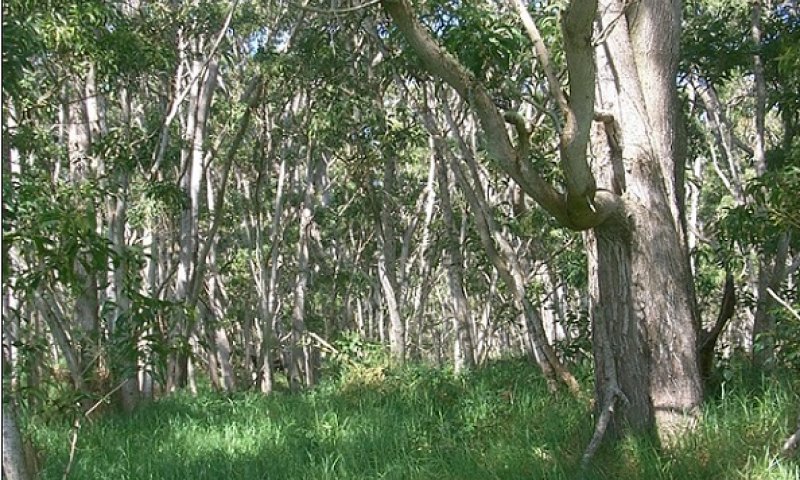
Figure 22. Dense koa regrowth. 01/06/09 D Clausnitzer generic photo
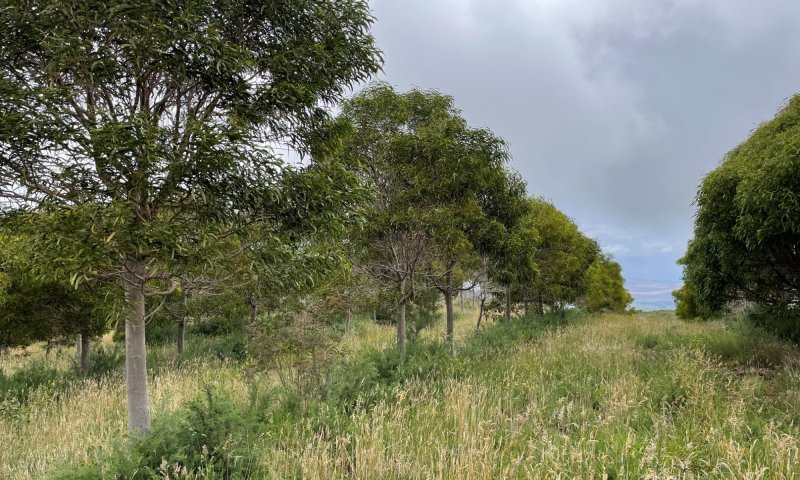
Figure 23. Koa plantation. Close up photo. MU ONE. Elevation 5,100 feet. Sweet vernal grass dominates the understory in this relatively open canopy. Common Gorse is problematic in this stand. John Proctor. 5/24/22.
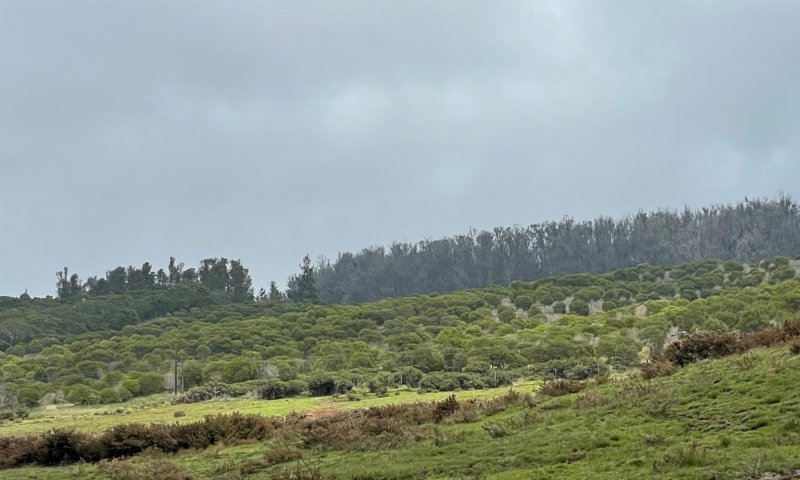
Figure 24. Koa plantation. Landscape photo. MU ONE. Elevation 5,100 feet. A dense stand of recently treated Common Gorse is dying in the foreground. John Proctor. 5/24/22.
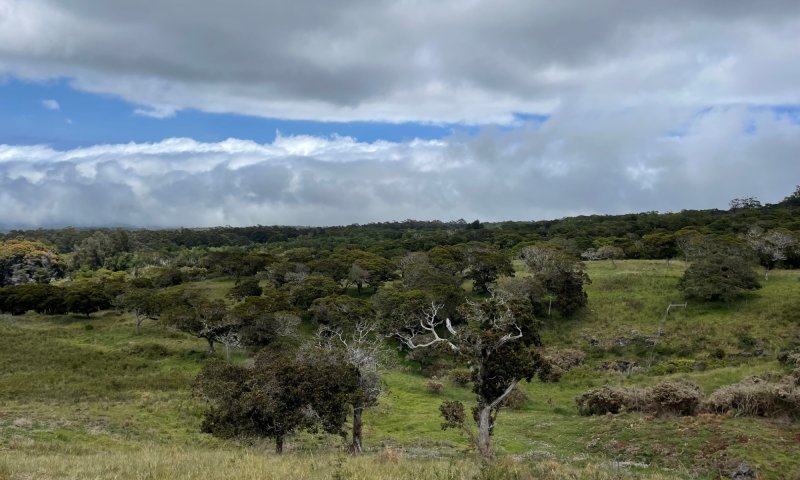
Figure 25. Ukulele is an area being actively restored to native forest. The area is fenced off in four quadrats to allow animals (cows, goats, sheep) to come in and graze down weeds (mainly blackberry and Himalayan ginger).
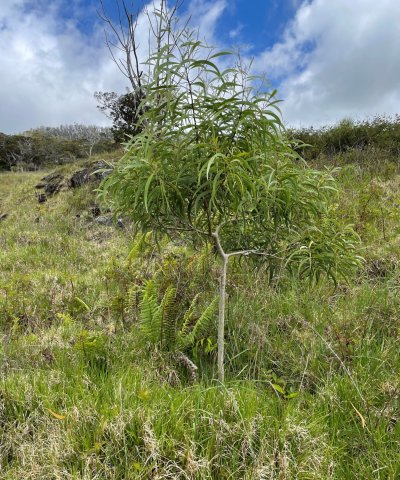
Figure 26. Ukulele is an area being actively restored to native forest by planting of canopy species, primarily koa and ‘ohi’a. Once the plantings are strong enough, the plan is to bring in animals again and work on understory species.
Koa seeds may remain viable in the soil for decades and can be induced to germinate by scarifying or scraping the soil surface with a bulldozer. If mature koa trees are present, suckers from their roots can quickly grow into spaces with sufficient sunlight. As the tree canopy closes, forage grasses are usually replaced by meadow ricegrass, which remains abundant unless killed by herbicide or suppressed by shadier conditions and heavy tree litter. Other native plant species will begin to grow in the understory if a seed source is nearby. As dense koa stands grow, all the trees may become stunted unless the stand is thinned.
Forest overstory. The overstory consists entirely of even-aged koa trees. Some older, larger remnant koa specimens may be present.
Forest understory. The understory may contain some native plants that opportunistically reenter the site. These include the tree mamani (Sophora chrysophylla), the shrubs aalii (Dodonaea viscosa) and pukiawe (Styphelia tameiameiae), the vines akala (Rubus argutus) and huehue (Cocculus orbiculatus), and the ferns io nui or alpine woodfern (Dryopteris wallichiana), western brackenfern Pteridium aquilinum), and oali or Cretan brake (Pteris cretica).
Introduced species in the understory are dominated by kikuyugrass and/or meadow ricegrass. Banana poka (Passiflora mollissima) may be present; it can smother tree canopies. A number of weedy forbs are usually present.
Dominant plant species
-
koa (Acacia koa), tree
-
kikuyugrass (Pennisetum clandestinum), grass
-
weeping grass (Microlaena stipoides), grass
Table 15. Soil surface cover
| Tree basal cover | 1-2% |
|---|---|
| Shrub/vine/liana basal cover | 0% |
| Grass/grasslike basal cover | 30-40% |
| Forb basal cover | 0% |
| Non-vascular plants | 0.1-1.0% |
| Biological crusts | 0% |
| Litter | 50-60% |
| Surface fragments >0.25" and <=3" | 0.1-1.0% |
| Surface fragments >3" | 0.1-1.0% |
| Bedrock | 0% |
| Water | 0% |
| Bare ground | 0-1% |
Table 16. Canopy structure (% cover)
| Height Above Ground (ft) | Tree | Shrub/Vine | Grass/ Grasslike |
Forb |
|---|---|---|---|---|
| <0.5 | 0% | 0% | 1-2% | 1-1% |
| >0.5 <= 1 | 0% | 0-1% | 25-30% | 1-2% |
| >1 <= 2 | 0% | 1-1% | 35-40% | 3-5% |
| >2 <= 4.5 | 0-1% | 1-1% | – | 1-1% |
| >4.5 <= 13 | 3-5% | – | – | – |
| >13 <= 40 | 55-65% | – | – | – |
| >40 <= 80 | – | – | – | – |
| >80 <= 120 | – | – | – | – |
| >120 | – | – | – | – |
State 4
Introduced Tree/Shrub-Invaded State
This state has one community dominated by either an invasive tree or an invasive shrub. Black wattle (Acacia mearnsii), is an extremely fast-growing tree currently choking pastures, gulches, and empty lots across 3,000 acres upcountry on Maui. Faya tree (Morella faya) is another problematic introduced tree which is capable of forming dense, single-species stands, devoid of other plant life. Gorse (Ulex europaeus) is a invasive shrub which was introduced intentionally to this ecological site early in the 20th century to function as a living fence livestock. It has since expanded its range and density considerably and now forms a monoculture on large acreages, primarily on Mauna Kea.
Community 4.1
Black wattle (Maui)/common gorse (mostly Hawaii)

Figure 27. Gorse stand with remnant koa trees near Hakalau. 06/25/08 D Clausnitzer generic photo
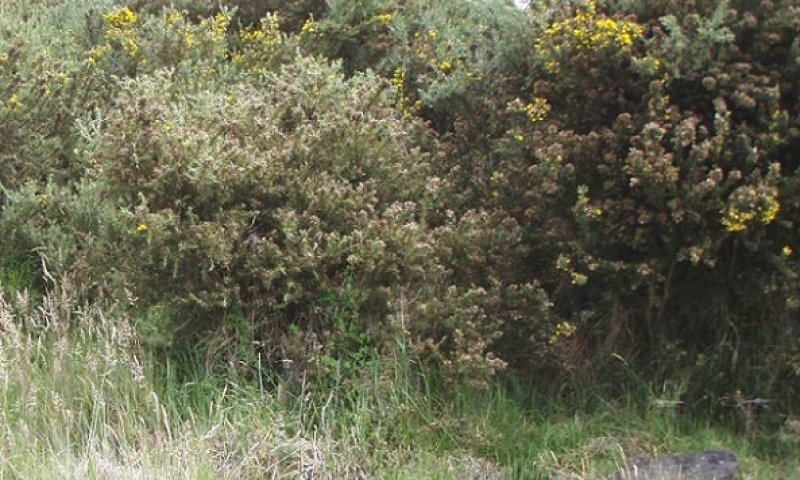
Figure 28. Solid gorse stand near Hakalau. 06/25/08 D Clausnitzer generic photo
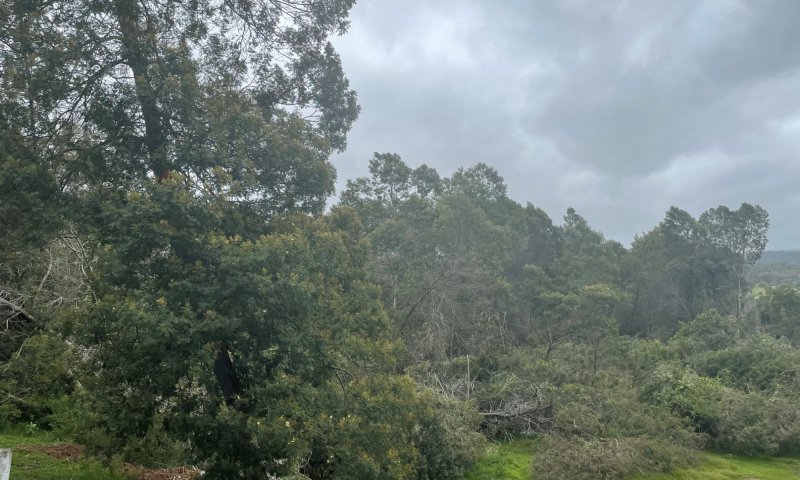
Figure 29. Solid black waddle stand near Kula. 05/06/22. J Proctor generic photo
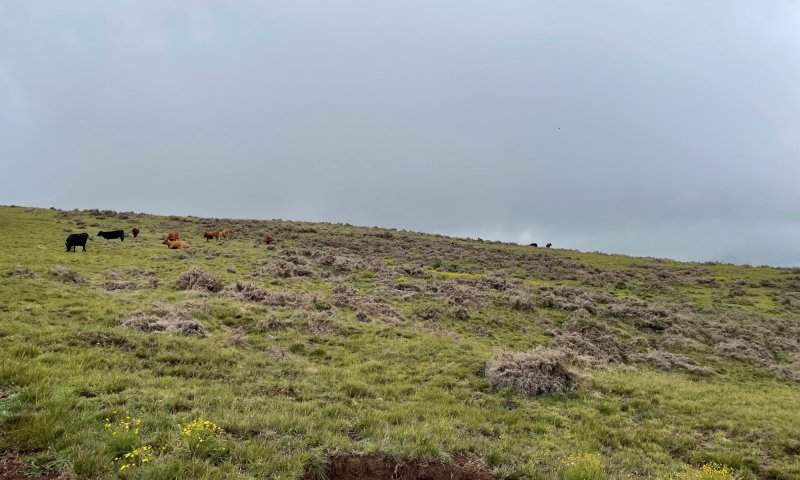
Figure 30. Mastication/Mow treatment of Gorse followed by herbicide application. A 2-3 year process requiring herbicidal maintenance to control recruitment from the seed bank. MU ONE. 5,100 ft. John Proctor. 5/24/22
Black wattle (Acacia mearnsii) is a nitrogen fixing evergreen tree which often reaches 65 feet (20 m) in height. Apart from producing copious numbers of seeds, it generates numerous suckers resulting in dense, pure, even-age thickets, especially where it has recolonized cleared land. The major infestations are primarily in and around Kula on the island of Maui. While birds and mammals provide potential dispersal mechanisms, the primary disseminator of this plant appears to be man. The species resprouts by basal shoots following fire, thereby generally intensifying the infestation. Faya tree (Morella faya) may be present and is problematic because it modifies forest habitat by significantly increasing nitrogen levels in the soil, making the area inhospitable to native plants, but more suitable for other invasive species. Faya tree seeds are spread by animals and it is able to colonize a wide range of habitats due to its ability to alter soil chemistry. Gorse (Ulex europaeus) forms a deep, dense, impenetrable thicket that largely excludes all other plant species. Scattered grasses and forbs are typically present in small numbers. Scattered, tall koa trees persist within these stands but are unable to reproduce. These sites are essentially wasteland. Gorse is extremely competitive with other vegetation, and it has long, sharp thorns that deter most browsing animals. The seeds are spread widely by birds.
Forest overstory. A few remnant koa (Acacia koa) trees may be present emerging from the gorse thicket.
Forest understory. A few small introduced forb and grass species exist where the gorse has not totally occupied the ground and canopy. These include fireweed or Madagascar ragwort (Senecio madagascariensis), narrowleaf plantain (Plantago lanceolata), common mullein (Verbascum thapsus), hairy catsear (Hypochaeris radicata), Chilean evening primrose (Oenothera stricta), common velvetgrass (Holcus lanatus), orchardgrass (Dactylis glomerata), rescuegrass (Bromus catharticus), sweet vernalgrass (Anthoxanthum odoratum), brome fescue (Vulpia bromoides), annual bluegrass (Poa annua), and kikuyugrass (Pennisetum clandestinum).
Dominant plant species
-
black wattle (Acacia mearnsii), tree
-
firetree (Morella faya), tree
-
common gorse (Ulex europaeus), shrub
Table 17. Soil surface cover
| Tree basal cover | 0% |
|---|---|
| Shrub/vine/liana basal cover | 3-4% |
| Grass/grasslike basal cover | 0.0-0.5% |
| Forb basal cover | 0% |
| Non-vascular plants | 0-1% |
| Biological crusts | 0-1% |
| Litter | 65-75% |
| Surface fragments >0.25" and <=3" | 0.1-1.0% |
| Surface fragments >3" | 0.1-1.0% |
| Bedrock | 0% |
| Water | 0% |
| Bare ground | 10-15% |
Table 18. Woody ground cover
| Downed wood, fine-small (<0.40" diameter; 1-hour fuels) | – |
|---|---|
| Downed wood, fine-medium (0.40-0.99" diameter; 10-hour fuels) | – |
| Downed wood, fine-large (1.00-2.99" diameter; 100-hour fuels) | – |
| Downed wood, coarse-small (3.00-8.99" diameter; 1,000-hour fuels) | – |
| Downed wood, coarse-large (>9.00" diameter; 10,000-hour fuels) | – |
| Tree snags** (hard***) | – |
| Tree snags** (soft***) | – |
| Tree snag count** (hard***) | 0 per acre |
| Tree snag count** (hard***) | 0 per acre |
* Decomposition Classes: N - no or little integration with the soil surface; I - partial to nearly full integration with the soil surface.
** >10.16cm diameter at 1.3716m above ground and >1.8288m height--if less diameter OR height use applicable down wood type; for pinyon and juniper, use 0.3048m above ground.
*** Hard - tree is dead with most or all of bark intact; Soft - most of bark has sloughed off.
Table 19. Canopy structure (% cover)
| Height Above Ground (ft) | Tree | Shrub/Vine | Grass/ Grasslike |
Forb |
|---|---|---|---|---|
| <0.5 | – | 0% | 1-2% | 0% |
| >0.5 <= 1 | – | 0% | 3-5% | 0-1% |
| >1 <= 2 | – | 0-1% | 1-2% | 0-1% |
| >2 <= 4.5 | – | 5-10% | 0-1% | 0-1% |
| >4.5 <= 13 | – | 75-85% | – | – |
| >13 <= 40 | 0% | – | – | – |
| >40 <= 80 | 0-1% | – | – | – |
| >80 <= 120 | – | – | – | – |
| >120 | – | – | – | – |
Transition T1A
State 1 to 2
State 1 Reference will transition to State 2 Naturalized Grassland by removing the native understory, either by fire, machinery, or, more gradually, by continuous disturbance by ungulates. Naturalized forage grasses may recruit voluntarily, or be established by sprigging or seeding.
Restoration pathway R2A
State 2 to 1
A facsimile of State 1 Reference may be restored directly from State 2 Naturalized Grassland. Weed control must be applied to grassland species and the many opportunistic plant species that invade the site. Weed control will be a perpetual process to maintain the site even after a canopy of native trees and shrubs has developed. All ungulates must be excluded from the restoration site by fences and hunting. Domestic ungulates would be useful to manage vegetation outside the restoration site perimeter. Extensive planting of native species would follow. Koa is the key species for restoration. It can be replanted, and in some cases it can be restored by scarifying the soil with heavy equipment if a sufficient seed bank remains in the soil. As an overstory canopy develops, the increased shade will cause a shift from warm-season kikuyugrass to cool-season, shade-tolerant meadow ricegrass (Microlaena stipoides). Meadow ricegrass can be almost as dense and detrimental to establishment of native plants as kikuyugrass. It may be possible to partially suppress meadow ricegrass by planting native shrubs that produce denser shade near the ground and litter that covers the grass, although herbicides will be more effective.
Restoration pathway R2B
State 2 to 3
State 2 Naturalized Grassland can be restored to State 3 Restored Koa either with the goal of creating stands of harvestable koa, creating a silvopastures, or as an intermediate step to State 1 Reference State. Koa trees can rapidly form a dense stand on these sites from seed bank germination stimulated by mechanical ground scarification, root suckering from remnant koa, and/or replanting. Weed control of unwanted vegetation, including forage grasses, is necessary to reduce competition with tree seedlings. Ungulates must be excluded for at least five to seven years to allow koa saplings to grow large enough to withstand the presence of animals.
Transition T2A
State 2 to 4
Gorse (Ulex europaeus) and/or black waddle (Acacia mearnsii) rapidly invades pastures when a seed source is nearby and eventually forms impenetrable thickets with very little understory. Inspection of grasslands for gorse and/or black waddle seedlings, followed by weed control is necessary to prevent this.
Restoration pathway R3A
State 3 to 1
State 3 Restored Koa can be restored to State 1 Reference. Weed control will be necessary to eliminate banana poka and other weeds that invade the site, as well as to reduce grass cover. Ungulates must be excluded from the site. Reintroduction of native understory plants is likely be necessary. Very dense stands of koa will benefit from thinning.
Restoration pathway R4A
State 4 to 2
It may be possible to restore state 4 Introduced Tree/Shrub-Invaded to State 2 Naturalized Grassland. Multiple weed control treatments are required followed by the removal of dead gorse and/or black waddle. The reestablishment of forage grasses may be necessary. However, gorse and/or black waddle seeds can persist and remain viable in the soil for decades, making continual control necessary.
Additional community tables
Table 20. Community 1.1 forest overstory composition
| Common name | Symbol | Scientific name | Nativity | Height (ft) | Canopy cover (%) | Diameter (in) | Basal area (square ft/acre) |
|---|---|---|---|---|---|---|---|
|
Tree
|
|||||||
| koa | ACKO | Acacia koa | Native | 40–80 | 30–40 | 20–87 | – |
| mamani | SOCH | Sophora chrysophylla | Native | 13–30 | 15–20 | – | – |
| mountain sandalwood | SAPA7 | Santalum paniculatum | Native | 13–40 | 5–10 | – | – |
| naio | MYSA | Myoporum sandwicense | Native | 13–30 | 5–7 | – | – |
| Lanai colicwood | MYLA3 | Myrsine lanaiensis | Native | 13–30 | 3–5 | – | – |
| alpine mirrorplant | COMO3 | Coprosma montana | Native | 13–35 | 3–5 | – | – |
| kolea lau nui | MYLE2 | Myrsine lessertiana | Native | 13–30 | 1–2 | – | – |
| koa | ACKO | Acacia koa | Native | 80–90 | 1–2 | – | – |
| alpine sandmat | CHOL3 | Chamaesyce olowaluana | Native | 13–25 | 0.5–1 | – | – |
| Mauna Kea dubautia | DUAR | Dubautia arborea | Native | 13–16 | 0.5–1 | – | – |
| Florida hopbush | DOVI | Dodonaea viscosa | Native | 13–20 | 0.5–1 | – | – |
| cheesewood | PITTO | Pittosporum | Native | 13–35 | 0.5–1 | – | – |
| mountain sandalwood | SAPA7 | Santalum paniculatum | Native | 40–50 | 0–1 | – | – |
| koa | ACKO | Acacia koa | Native | 13–40 | 0.5–1 | – | – |
| 'ohi'a lehua | MEPO5 | Metrosideros polymorpha | Native | 13–40 | 0–0.1 | – | – |
| 'ohi'a lehua | MEPO5 | Metrosideros polymorpha | Native | 40–60 | 0–0.1 | – | – |
Table 21. Community 1.1 forest understory composition
| Common name | Symbol | Scientific name | Nativity | Height (ft) | Canopy cover (%) | |
|---|---|---|---|---|---|---|
|
Grass/grass-like (Graminoids)
|
||||||
| alpine hairgrass | DENU6 | Deschampsia nubigena | Native | 1–2 | 1–2 | |
| mountain lovegrass | ERLE3 | Eragrostis leptophylla | Native | 1–2 | 0–1 | |
| parkland panicgrass | PATE6 | Panicum tenuifolium | Native | 1–2 | 0–1 | |
| Oahu sedge | CAWA | Carex wahuensis | Native | 0.5–1 | 0.1–1 | |
| Hawai'i woodrush | LUHA2 | Luzula hawaiiensis | Native | 0.5–1 | 0–1 | |
| pili uka | TRGL3 | Trisetum glomeratum | Native | 1–2 | 0–1 | |
| Hawai'i bentgrass | AGSA3 | Agrostis sandwicensis | Native | 1–2 | 0–1 | |
| brown sedge | CASU6 | Carex subfusca | Native | 0.5–1 | 0–0.5 | |
|
Forb/Herb
|
||||||
| viper beggarticks | BICA2 | Bidens campylotheca | Native | 2–5 | 1–2 | |
| Sandwich beach strawberry | FRCHS2 | Fragaria chiloensis ssp. sandwicensis | Native | 0.2–0.5 | 0.1–0.5 | |
| Hawai'ian buttercup | RAHA2 | Ranunculus hawaiensis | Native | 1–3 | 0.1–0.5 | |
| Trans-Pecos cliffbrake | PETE2 | Pellaea ternifolia | Native | 0.2–0.5 | 0–0.1 | |
| Hawai'i stingingnettle | HESA5 | Hesperocnide sandwicensis | Native | 1–2 | 0–0.1 | |
| Kaumahana | KOCO | Korthalsella complanata | Native | 0.2–0.5 | 0–0.1 | |
| Hawai'i korthal mistletoe | KOCY | Korthalsella cylindrica | Native | 0.2–0.5 | 0–0.1 | |
| Hawai'i pokeweed | PHSA2 | Phytolacca sandwicensis | Native | 2–4 | 0–0.1 | |
| 'ena'ena | PSSA8 | Pseudognaphalium sandwicensium | Native | 0.5–2 | 0–0.1 | |
|
Fern/fern ally
|
||||||
| alpine woodfern | DRWA | Dryopteris wallichiana | Native | 1–2 | 0.1–1 | |
| western brackenfern | PTAQ | Pteridium aquilinum | Native | 1–2 | 0–1 | |
| Cretan brake | PTCR2 | Pteris cretica | Native | 0.2–0.5 | 0–0.1 | |
| maidenhair spleenwort | ASTR2 | Asplenium trichomanes | Native | 0.2–0.5 | 0–0.1 | |
| black spleenwort | ASAD | Asplenium adiantum-nigrum | Native | 0.5–1 | 0–0.1 | |
|
Shrub/Subshrub
|
||||||
| Hawai'i hawthorn | OSAN | Osteomeles anthyllidifolia | Native | 2–8 | 5–10 | |
| Florida hopbush | DOVI | Dodonaea viscosa | Native | 2–13 | 3–5 | |
| pukiawe | STTA | Styphelia tameiameiae | Native | 2–6 | 3–5 | |
| 'aiakanene | COER3 | Coprosma ernodeoides | Native | 0.5–2 | 3–5 | |
| Mauna Loa beggarticks | BIME | Bidens menziesii | Native | 2–6 | 1–2 | |
| yellow ‘ilima | SIFA | Sida fallax | – | 2–4 | 1–2 | |
| ohelo 'ai | VARE | Vaccinium reticulatum | Native | 2–3 | 1–2 | |
| pukamole | LYMA3 | Lythrum maritimum | Native | 2–3 | 0.5–1 | |
| pawale | RUGI | Rumex giganteus | Native | 2–4 | 0.5–1 | |
| Mauna Kea dubautia | DUAR | Dubautia arborea | Native | 2–13 | 0–1 | |
| lava dubautia | DUCI | Dubautia ciliolata | Native | 2–6 | 0–1 | |
| shrubland dubautia | DULI | Dubautia linearis | Native | 2–5 | 0–1 | |
| hillside clermontia | CLLI3 | Clermontia lindseyana | Native | 4–6 | 0–0.5 | |
|
Tree
|
||||||
| mamani | SOCH | Sophora chrysophylla | Native | 2–13 | 5–7 | |
| naio | MYSA | Myoporum sandwicense | Native | 2–13 | 3–5 | |
| koa | ACKO | Acacia koa | Native | 2–13 | 1–3 | |
| mountain sandalwood | SAPA7 | Santalum paniculatum | Native | 2–13 | 0.1–2 | |
| alpine mirrorplant | COMO3 | Coprosma montana | Native | 2–13 | 1–2 | |
| alpine sandmat | CHOL3 | Chamaesyce olowaluana | Native | 2–13 | 1–2 | |
| Lanai colicwood | MYLA3 | Myrsine lanaiensis | Native | 2–13 | 0–1 | |
| kolea lau nui | MYLE2 | Myrsine lessertiana | Native | 2–13 | 0–1 | |
| cheesewood | PITTO | Pittosporum | Native | 2–13 | 0–0.1 | |
| 'ohi'a lehua | MEPO5 | Metrosideros polymorpha | Native | 2–13 | 0–0.1 | |
|
Vine/Liana
|
||||||
| littleleaf stenogyne | STMI3 | Stenogyne microphylla | Native | 2–4 | 3–5 | |
| Hawai'i blackberry | RUHA | Rubus hawaiensis | Native | 2–4 | 1–2 | |
| queen coralbead | COOR11 | Cocculus orbiculatus | Native | 0.5–4 | 0.5–1 | |
| lava bur cucumber | SIAN4 | Sicyos anunu | Native | 1–5 | 0.5–1 | |
Table 22. Community 2.1 plant community composition
| Group | Common name | Symbol | Scientific name | Annual production (lb/acre) | Foliar cover (%) | |
|---|---|---|---|---|---|---|
|
Grass/Grasslike
|
||||||
| 1 | Naturalized Warm Season Grasses | 3200–3800 | ||||
| kikuyugrass | PECL2 | Pennisetum clandestinum | 3200–3800 | – | ||
| smut grass | SPIN4 | Sporobolus indicus | 0–25 | – | ||
| 2 | Naturalized Cool Season Grasses | 0–200 | ||||
| sweet vernalgrass | ANOD | Anthoxanthum odoratum | 0–125 | – | ||
| common velvetgrass | HOLA | Holcus lanatus | 0–125 | – | ||
| orchardgrass | DAGL | Dactylis glomerata | 0–125 | – | ||
| tufted lovegrass | ERPE | Eragrostis pectinacea | 0–50 | – | ||
| perennial ryegrass | LOPE | Lolium perenne | 0–50 | – | ||
| Kentucky bluegrass | POPR | Poa pratensis | 0–50 | – | ||
| brome fescue | VUBR | Vulpia bromoides | 0–50 | – | ||
| rescuegrass | BRCA6 | Bromus catharticus | 0–50 | – | ||
|
Forb
|
||||||
| 3 | Naturalized Forbs | 0–200 | ||||
| hairy cat's ear | HYRA3 | Hypochaeris radicata | 0–125 | – | ||
| red clover | TRPR2 | Trifolium pratense | 0–125 | – | ||
| white clover | TRRE3 | Trifolium repens | 0–125 | – | ||
| suckling clover | TRDU2 | Trifolium dubium | 0–50 | – | ||
| common sheep sorrel | RUAC3 | Rumex acetosella | 0–25 | – | ||
| rabbitfoot clover | TRAR4 | Trifolium arvense | 0–25 | – | ||
|
Tree
|
||||||
| 4 | Native Trees | 0–100 | ||||
| koa | ACKO | Acacia koa | 0–100 | – | ||
| mamani | SOCH | Sophora chrysophylla | 0–50 | – | ||
Table 23. Community 2.2 forest overstory composition
| Common name | Symbol | Scientific name | Nativity | Height (ft) | Canopy cover (%) | Diameter (in) | Basal area (square ft/acre) |
|---|---|---|---|---|---|---|---|
|
Tree
|
|||||||
| koa | ACKO | Acacia koa | Native | 40–80 | 0–1 | – | – |
| koa | ACKO | Acacia koa | Native | 13–40 | 0–1 | – | – |
| mamani | SOCH | Sophora chrysophylla | Native | 13–20 | 0–0.1 | – | – |
| mountain sandalwood | SAPA7 | Santalum paniculatum | Native | 20–40 | – | – | – |
Table 24. Community 2.2 forest understory composition
| Common name | Symbol | Scientific name | Nativity | Height (ft) | Canopy cover (%) | |
|---|---|---|---|---|---|---|
|
Grass/grass-like (Graminoids)
|
||||||
| sweet vernalgrass | ANOD | Anthoxanthum odoratum | Introduced | 1–2 | 35–40 | |
| kikuyugrass | PECL2 | Pennisetum clandestinum | Introduced | 0.5–1 | 15–20 | |
| common velvetgrass | HOLA | Holcus lanatus | Introduced | 1–2 | 10–15 | |
| orchardgrass | DAGL | Dactylis glomerata | Introduced | 1–3 | 10–15 | |
| rescuegrass | BRCA6 | Bromus catharticus | Introduced | 2–3 | 3–5 | |
| brome fescue | VUBR | Vulpia bromoides | Introduced | 0.2–0.5 | 0.5–1 | |
| annual fescue | VUMY | Vulpia myuros | Introduced | 0.2–0.5 | 0.5–1 | |
| tufted lovegrass | ERPE | Eragrostis pectinacea | Introduced | 1–2 | 0.5–1 | |
| annual bluegrass | POAN | Poa annua | Introduced | 0.2–0.5 | 0.5–1 | |
|
Forb/Herb
|
||||||
| Madagascar ragwort | SEMA15 | Senecio madagascariensis | Introduced | 0.5–1 | 5–10 | |
| narrowleaf plantain | PLLA | Plantago lanceolata | Introduced | 0.2–0.5 | 3–5 | |
| hairy cat's ear | HYRA3 | Hypochaeris radicata | Introduced | 0.2–0.5 | 0.5–1 | |
| Peruvian groundcherry | PHPE4 | Physalis peruviana | Introduced | 1–2 | 0.1–0.5 | |
| common sheep sorrel | RUAC3 | Rumex acetosella | Introduced | 0.2–0.5 | 0.1–0.5 | |
| Chilean evening primrose | OEST | Oenothera stricta | Introduced | 0.5–1 | 0.1–0.5 | |
| common mullein | VETH | Verbascum thapsus | Introduced | 2–3 | 0.1–0.5 | |
| bull thistle | CIVU | Cirsium vulgare | Introduced | 1–3 | 0–0.1 | |
|
Shrub/Subshrub
|
||||||
| Florida hopbush | DOVI | Dodonaea viscosa | Native | 2–4 | – | |
| yellow ‘ilima | SIFA | Sida fallax | Native | 1–3 | – | |
Table 25. Community 2.3 forest overstory composition
| Common name | Symbol | Scientific name | Nativity | Height (ft) | Canopy cover (%) | Diameter (in) | Basal area (square ft/acre) |
|---|---|---|---|---|---|---|---|
|
Tree
|
|||||||
| koa | ACKO | Acacia koa | Native | 40–80 | 0–1 | – | – |
| koa | ACKO | Acacia koa | Native | 13–40 | 0–1 | – | – |
Table 26. Community 2.3 forest understory composition
| Common name | Symbol | Scientific name | Nativity | Height (ft) | Canopy cover (%) | |
|---|---|---|---|---|---|---|
|
Grass/grass-like (Graminoids)
|
||||||
| sweet vernalgrass | ANOD | Anthoxanthum odoratum | Introduced | 1–2 | 45–55 | |
| rescuegrass | BRCA6 | Bromus catharticus | Introduced | 2–3 | 10–15 | |
| kikuyugrass | PECL2 | Pennisetum clandestinum | Introduced | 0.5–1 | 3–5 | |
| common velvetgrass | HOLA | Holcus lanatus | Introduced | 1–2 | 3–5 | |
| orchardgrass | DAGL | Dactylis glomerata | Introduced | 1–2 | 0.5–1 | |
| Bermudagrass | CYDA | Cynodon dactylon | Introduced | 0.1–0.3 | 0.5–1 | |
| Cuming's lovegrass | ERCU5 | Eragrostis cumingii | Introduced | 1–2 | 0.5–1 | |
| rose Natal grass | MERE9 | Melinis repens | Introduced | 1–2 | 0.5–1 | |
| brome fescue | VUBR | Vulpia bromoides | Introduced | 0.5–1 | 0.5–1 | |
| annual fescue | VUMY | Vulpia myuros | Introduced | 0.5–1 | 0.5–1 | |
| annual bluegrass | POAN | Poa annua | Introduced | 0.2–0.5 | 0.5–1 | |
|
Forb/Herb
|
||||||
| Madagascar ragwort | SEMA15 | Senecio madagascariensis | Introduced | 0.5–1 | 30–40 | |
| narrowleaf plantain | PLLA | Plantago lanceolata | Introduced | 0.2–0.5 | 3–5 | |
| Australasian geranium | GEHO5 | Geranium homeanum | Introduced | 0.2–0.5 | 0.5–1 | |
| common yarrow | ACMI2 | Achillea millefolium | Introduced | 0.5–1 | 0.5–1 | |
| hairy beggarticks | BIPI | Bidens pilosa | Introduced | 0.5–1 | 0.5–1 | |
| black mustard | BRNI | Brassica nigra | Introduced | 1–2 | 0.5–1 | |
| cultivated radish | RASA2 | Raphanus sativus | Introduced | 1–2 | 0.5–1 | |
| smooth hawksbeard | CRCA3 | Crepis capillaris | Introduced | 1–2 | 0.5–1 | |
| woodland ragwort | SESY | Senecio sylvaticus | Introduced | 0.5–1 | 0.5–1 | |
| old-man-in-the-Spring | SEVU | Senecio vulgaris | Introduced | 1–2 | 0.5–1 | |
| hairy cat's ear | HYRA3 | Hypochaeris radicata | Introduced | 0.2–0.5 | 0.5–1 | |
| telegraphweed | HEGR7 | Heterotheca grandiflora | Introduced | 1–2 | 0.5–1 | |
| Chilean evening primrose | OEST | Oenothera stricta | Introduced | 0.5–1 | 0.5–1 | |
| sweet fennel | FOVU | Foeniculum vulgare | Introduced | 1–2 | 0.5–1 | |
| golden crownbeard | VEEN | Verbesina encelioides | Introduced | 1–2 | 0.5–1 | |
| common mullein | VETH | Verbascum thapsus | Introduced | 2–3 | 0.5–1 | |
| bull thistle | CIVU | Cirsium vulgare | Introduced | 1–2 | – | |
|
Shrub/Subshrub
|
||||||
| Florida hopbush | DOVI | Dodonaea viscosa | Native | 1–3 | – | |
| yellow ‘ilima | SIFA | Sida fallax | Native | 1–2 | – | |
Table 27. Community 3.1 forest overstory composition
| Common name | Symbol | Scientific name | Nativity | Height (ft) | Canopy cover (%) | Diameter (in) | Basal area (square ft/acre) |
|---|---|---|---|---|---|---|---|
|
Tree
|
|||||||
| koa | ACKO | Acacia koa | Native | 13–25 | 55–65 | 2–4 | – |
| koa | ACKO | Acacia koa | Native | 2–13 | 3–5 | – | – |
Table 28. Community 3.1 forest understory composition
| Common name | Symbol | Scientific name | Nativity | Height (ft) | Canopy cover (%) | |
|---|---|---|---|---|---|---|
|
Grass/grass-like (Graminoids)
|
||||||
| weeping grass | MIST | Microlaena stipoides | Introduced | 1–1.5 | 35–45 | |
| kikuyugrass | PECL2 | Pennisetum clandestinum | Introduced | 0.5–1 | 25–35 | |
| sweet vernalgrass | ANOD | Anthoxanthum odoratum | Introduced | 1–2 | 1–2 | |
| common velvetgrass | HOLA | Holcus lanatus | Introduced | 1–2 | 1–2 | |
|
Forb/Herb
|
||||||
| spreading snakeroot | AGRI2 | Ageratina riparia | Introduced | 1–2 | 0.5–1 | |
| Australasian geranium | GEHO5 | Geranium homeanum | Introduced | 0.5–1 | 0.5–1 | |
| narrowleaf plantain | PLLA | Plantago lanceolata | Introduced | 0.2–0.5 | 0.5–1 | |
| Peruvian groundcherry | PHPE4 | Physalis peruviana | Introduced | 2–3 | 0.5–1 | |
| Jerusalem cherry | SOPS | Solanum pseudocapsicum | Introduced | 2–3 | 0.5–1 | |
|
Fern/fern ally
|
||||||
| western brackenfern | PTAQ | Pteridium aquilinum | Native | 1–2 | 3–5 | |
| alpine woodfern | DRWA | Dryopteris wallichiana | Native | 1–2 | 0.5–1 | |
| Cretan brake | PTCR2 | Pteris cretica | Native | 0.2–0.5 | 0.1–0.5 | |
|
Shrub/Subshrub
|
||||||
| Florida hopbush | DOVI | Dodonaea viscosa | Native | 1–4 | 0.5–1 | |
| pukiawe | STTA | Styphelia tameiameiae | Native | 2–4 | 0.1–0.5 | |
|
Tree
|
||||||
| mamani | SOCH | Sophora chrysophylla | – | 5–13 | 0.1–0.5 | |
|
Vine/Liana
|
||||||
| sawtooth blackberry | RUAR2 | Rubus argutus | Introduced | 2–4 | 0.1–1 | |
| queen coralbead | COOR11 | Cocculus orbiculatus | Native | 1–5 | 0.1–0.5 | |
Table 29. Community 4.1 forest overstory composition
| Common name | Symbol | Scientific name | Nativity | Height (ft) | Canopy cover (%) | Diameter (in) | Basal area (square ft/acre) |
|---|---|---|---|---|---|---|---|
|
Tree
|
|||||||
| koa | ACKO | Acacia koa | Native | 40–70 | 0–1 | – | – |
Table 30. Community 4.1 forest understory composition
| Common name | Symbol | Scientific name | Nativity | Height (ft) | Canopy cover (%) | |
|---|---|---|---|---|---|---|
|
Grass/grass-like (Graminoids)
|
||||||
| common velvetgrass | HOLA | Holcus lanatus | Introduced | 1–2 | 0.5–1 | |
| kikuyugrass | PECL2 | Pennisetum clandestinum | Introduced | 0.5–1 | 0–0.5 | |
| orchardgrass | DAGL | Dactylis glomerata | Introduced | 1–2 | 0–0.1 | |
| rescuegrass | BRCA6 | Bromus catharticus | Introduced | 1–2 | 0–0.1 | |
| sweet vernalgrass | ANOD | Anthoxanthum odoratum | Introduced | 1–2 | 0–0.1 | |
| brome fescue | VUBR | Vulpia bromoides | Introduced | 0.2–0.5 | 0–0.1 | |
| annual bluegrass | POAN | Poa annua | Introduced | 0.2–0.5 | 0–0.1 | |
|
Forb/Herb
|
||||||
| Chilean evening primrose | OEST | Oenothera stricta | Introduced | 0.5–1 | 0–0.1 | |
| Madagascar ragwort | SEMA15 | Senecio madagascariensis | Introduced | 0.5–1 | 0–0.1 | |
| narrowleaf plantain | PLLA | Plantago lanceolata | Introduced | 0.2–0.5 | 0–0.1 | |
| common mullein | VETH | Verbascum thapsus | Introduced | 2–3 | 0–0.1 | |
| hairy cat's ear | HYRA3 | Hypochaeris radicata | Introduced | 0.2–0.5 | 0–0.1 | |
|
Shrub/Subshrub
|
||||||
| common gorse | ULEU | Ulex europaeus | Introduced | 4–13 | 75–85 | |
| common gorse | ULEU | Ulex europaeus | Introduced | 2–4 | 5–10 | |
Interpretations
Animal community
Native Wildlife
The Reference State of this ecological site can support a variety of native birds, including elepaio (Chasiempis sandwichensis bryani), amakihi (Hemignathus virens), apapane (Himatione sanguinea), and iiwi (Vestiaria coccinea). It also is home to the Hawaiian hoary bat or opeapea (Lasiurus cenarius semotus). These species may be encountered within community phases with native tree cover. Community phases that provide open grassland or savanna-like settings provide habitat for the native Hawaiian owl or pueo (Asio flammeus spp. sandwichensis) and the Hawaiian hawk or io (Buteo solitarius).
A large number of native bird species have gone extinct both before and after European contact.
Introduced Wildlife
This ecological site provides habitat to a variety of introduced birds. Species such as wild turkey (Meleagris gallopavo), ring-necked pheasant (Phasianus colchicus), Erckel’s francolin (Pternistis erckelii), black francolin (Francolinus francolinus), and kalij pheasant (Lophura leucomelanos) are considered to be game birds.
Feral pigs and sheep are common. They provide hunting opportunities but are destructive to native vegetation. Public sport hunting typically does not have a major impact on their populations; exclusion by fences followed by intensive hunting and trapping within exclusion areas is necessary to eliminate feral animals.
Feral cats are present and are a threat to native bird species.
Introduced wildlife species are able to utilize all community phases within the ecological site.
Grazing Interpretations
The following table lists suggested initial stocking rates for cattle under the Forage Value Rating system for only community phase 2.1. These are conservative estimates that should be used only as guidelines in the initial stages of the conservation planning process. Sometimes the current plant composition does not entirely match any particular plant community described in this ecological site description. Because of this, a field visit is recommended to document plant composition and production. More precise carrying capacity estimates should eventually be calculated using the following stocking rate information along with animal preference data, particularly when grazers other than cattle are involved. Under more intensive grazing management, improved harvest efficiencies may result in an increased stocking rate.
Forage Value Rating (note 1)
Very High (note 2) 0.40-0.59 acre/AUM (note 3) 2.56-1.70 AUM/acre
High 0.59-0.78 acre/AUM 1.70-1.28 AUM/acre
Moderate 0.78-1.56 acre/AUM 1.28-0.64 AUM/acre
Low 1.56-+ acre/AUM 0.64-+ AUM/acre
(note 1) The Forage Value Rating System is not an ecological evaluation of community phase 2.1. It is a utilitarian rating of the existing forage value for that specific plant community.
(note 2) Conservationists must use considerable judgment, because some pastures in the Very High forage class could be producing less than normal volumes of forage, and adjustments would need to be made in the initial stocking rate.
(note 3) Stocking rates vary in accordance with such factors as kind and class of livestock or wildlife, season of use, and fluctuations in climate. Actual use records and on-site inventories for individual sites, together with a determination of the degree to which the sites have been grazed, offer the most reliable basis for developing initial stocking rates.
This plant community is suitable for grazing by all kinds and classes of livestock, at any season, particularly cattle. However, this site is best utilized for grazing during the major plant growth period described in the “Climate” section. This site is suited for grazing by both cow-calf operations and stocker operations. However, sheep can be grazed on this site as well. This site is poorly suited to continuous year-long use if the condition of the plant community is to be maintained. Herbaceous forage can be deficient in protein during the drier months.
Hydrological functions
Most of the community phases of this ecological site are covered by vegetation and probably not prone to excessive soil erosion. Community phases 2.2 and especially 2.3 have high percentages of bare ground and are prone to excessive erosion.
Recreational uses
Hunting of introduced ungulates and game birds is the most common recreational use. Access by vehicle on gravel or dirt roads and on foot is easy in many areas.
Wood products
Mountain sandalwood was a valuable wood product in the past. There are no current wood products harvested from this ecological site. However, recent reestablishment of koa in limited areas may lead to valuable harvests in the future.
Other products
None.
Other information
Definitions
These definitions have been greatly simplified for brevity and do not cover every aspect of each topic.
Aa lava: A type of basaltic lava having a rough, jagged, clinkery surface and a vesicular interior.
Alluvial: Materials or processes associated with transportation and/or deposition by running water.
Aquic soil moisture regime: A regime in which the soil is free of dissolved oxygen because it is saturated by water. This regime typically exists in bogs or swamps.
Aridic soil moisture regime: A regime in which defined parts of the soil are, in normal years, dry for more than half of the growing season and moist for less than 90 consecutive days during the growing season. In Hawaii it is associated with hot, dry areas with plants such as kiawe, wiliwili, and buffelgrass. The terms aridic and torric are basically the same.
Ash field: a land area covered by a thick or distinctive deposit of volcanic ash that can be traced to a specific source and has well defined boundaries. The term “ash flow” is erroneously used in the Physiographic section of this ESD due to a flaw in the national database.
Ashy: A “soil texture modifier” for volcanic ash soils having a water content at the crop wilting point of less than 30 percent; a soil that holds relatively less water than “medial” and “hydrous” soils.
Available water capacity: The amount of soil water available to plants to the depth of the first root-restricting layer.
Basal area or basal cover: The cross sectional area of the stem or stems of a plant or of all plants in a stand.
Blue rock: The dense, hard, massive lava that forms the inner core of an aa lava flow.
Bulk density: the weight of dry soil per unit of volume. Lower bulk density indicates a greater amount of pore space that can hold water and air in a soil.
CaCO3 equivalent: The amount of free lime in a soil. Free lime exists as solid material and typically occurs in regions with a dry climate.
Canopy cover: The percentage of ground covered by the vertical projection downward of the outermost perimeter of the spread of plant foliage. Small openings within the canopy are included.
Community pathway: A description of the causes of shifts between community phases. A community pathway is reversible and is attributable to succession, natural disturbances, short-term climatic variation, and facilitating practices, such as grazing management.
Community phase: A unique assemblage of plants and associated dynamic soil properties within a state.
Dominant species: Plant species or species groups that exert considerable influence upon a community due to size, abundance, or cover.
Drainage class: The frequency and duration of a water table in a soil. There are seven drainage classes, ranging from “excessively drained” (soils with very rare or very deep water tables) to “well drained” (soils that provide ample water for plant growth but are not so wet as to inhibit root growth) to “very poorly drained” (soils with a water table at or near the surface during much of the growing season that inhibits growth of most plants).
Electrical conductivity (EC): A measure of the salinity of a soil. The standard unit is deciSiemens per meter (dS/m), which is numerically equivalent to millimhos per centimeter (mmhos/cm). An EC greater than about 4 dS/m indicates a salinity level that is unfavorable to growth of most plants.
Friability: A soil consistency term pertaining to the ease of crumbling of soils.
Hydrous: A “soil texture modifier” for volcanic ash soils having a water content at the crop wilting point of 100 percent or more; a soil that holds more water than “medial” or “ashy” soils.
Ion exchange capacity: The ability of soil materials such as clay or organic matter to retain ions (which may be plant nutrients) and to release those ions for uptake by roots.
Isohyperthermic soil temperature regime: A regime in which mean annual soil temperature is 72 degrees F (22 degrees C) or higher and mean summer and mean winter soil temperatures differ by less than 11 degrees F (6 degrees C) at a specified depth.
Isomesic soil temperature regime: A regime in which mean annual soil temperature is 47 degrees F (8 degrees C) or higher but lower than 59 degrees F (15 degrees C) and mean summer and mean winter soil temperatures differ by less than 11 degrees F (6 degrees C) at a specified depth.
Isothermic soil temperature regime: A regime in which mean annual soil temperature is 59 degrees F (15 degrees C) or higher but lower than 72 degrees F (22 degrees C) and mean summer and mean winter soil temperatures differ by less than 11 degrees F (6 degrees C) at a specified depth.
Kipuka: An area of land surrounded by younger (more recent) lava. Soils and plant communities within a kipuka are older than, and often quite different from, those on the surrounding surfaces.
Major Land Resource Area (MLRA): A geographic area defined by NRCS that is characterized by a particular pattern of soils, climate, water resources, and land uses. The island of Hawaii contains nine MLRAs, some of which also occur on other islands in the state.
Makai: a Hawaiian word meaning “toward the sea.”
Mauka: a Hawaiian word meaning “toward the mountain” or “inland.”
Medial: A “soil texture modifier” for volcanic ash soils having a water content at the crop wilting point of 30 to 100 percent; a soil that holds an amount of water intermediate to “hydrous” or “ashy” soils.
Naturalized plant community: A community dominated by adapted, introduced species. It is a relatively stable community resulting from secondary succession after disturbance. Most grasslands in Hawaii are in this category.
Pahoehoe lava: A type of basaltic lava with a smooth, billowy, or rope-like surface and vesicular interior.
Parent material: Unconsolidated and chemically weathered material from which a soil is developed.
Perudic soil moisture regime: A very wet regime found where precipitation exceeds evapotranspiration in all months of normal years. On the island of Hawaii, this regime is found on top of Kohala and on parts of the windward side of Mauna Kea.
pH: The numerical expression of the relative acidity or alkalinity of a soil sample. A pH of 7 is neutral; a pH below 7 is acidic and a pH above 7 is basic.
Phosphorus adsorption: The ability of soil materials to tightly retain phosphorous ions, which are a plant nutrient. Some volcanic ash soils retain phosphorus so strongly that it is partly unavailable to plants.
Reference community phase: The phase exhibiting the characteristics of the reference state and containing the full complement of plant species that historically occupied the site. It is the community phase used to classify an ecological site.
Reference state: A state that describes the ecological potential and natural or historical range of variability of an ecological site.
Restoration pathway: A term describing the environmental conditions and practices that are required to recover a state that has undergone a transition.
Sodium adsorption ratio (SAR): A measure of the amount of dissolved sodium relative to calcium and magnesium in the soil water. SAR values higher than 13 create soil conditions unfavorable to most plants.
Soil moisture regime: A term referring to the presence or absence either of ground water or of water held at a tension of less than 1500 kPa (the crop wilting point) in the soil or in specific horizons during periods of the year.
Soil temperature regime: A defined class based on mean annual soil temperature and on differences between summer and winter temperatures at a specified depth.
Soil reaction: Numerical expression in pH units of the relative acidity or alkalinity or a soil.
State: One or more community phases and their soil properties that interact with the abiotic and biotic environment to produce persistent functional and structural attributes associated with a characteristic range of variability.
State-and-transition model: A method used to display information about relationships between vegetation, soil, animals, hydrology, disturbances, and management actions on an ecological site.
Torric soil moisture regime: See Aridic soil moisture regime.
Transition: A term describing the biotic or abiotic variables or events that contribute to loss of state resilience and result in shifts between states.
Udic soil moisture regime: A regime in which the soil is not dry in any part for as long as 90 cumulative days in normal years, and so provides ample moisture for plants. In Hawaii it is associated with forests in which hapuu (tree ferns) are usually moderately to highly abundant.
Ustic soil moisture regime: A regime in which moisture is limited but present at a time when conditions are suitable for plant growth. In Hawaii it usually is associated with dry forests and subalpine shrublands.
Supporting information
Type locality
| Location 1: Hawaii County, HI | |
|---|---|
| Latitude | 19° 49′ 23″ |
| Longitude | 155° 20′ 19″ |
| General legal description | 100 yards mauka of Mana Road, above Hakalau NWR, east face of Mauna Kea. |
| Location 2: Hawaii County, HI | |
| Latitude | 19° 41′ 15″ |
| Longitude | 155° 27′ 56″ |
| General legal description | Puuhuluhulu, next to old Saddle Road. |
Other references
Abrahamson I. 2013. Fire regimes in Hawaiian plant communities. In: Fire Effects Information System, US Dept. of Agriculture, Forest Service, Rocky Mountain Research Station, Fire Sciences Laboratory. Available" www.fs.fed.us/database/feis/fire_regimes/Hawaii/all.html Review of fire regimes and history for multiple generalized plant communities in the Hawaiian Islands.
Armstrong RW. 1973. Atlas of Hawaii. University of Hawai`i Press, Honolulu. General reference for climate, land use, land forms, etc.
Athens JS. Ch. 12 Hawaiian Native Lowland Vegetation, IN Prehistory in Historical Ecology in the Pacific Islands – Prehistoric Environmental and Landscape Change. Kirch, PV and TL Hunt, eds. 1997. Yale U. Press, New Haven. General discussion of effects of prehistoric Polynesians on native lowland vegetation.
Burney DA, HF James, LP Burney, SL Olson, W Kikuchi, WL Wagner, M Burney, D McCloskey, D Kikuchi, FV Grady, R Gage II, and R Nishek. 2001. Fossil evidence diverse biota from Kauai and its transformation since human arrival. Ecological Monographs 71:615-641. Investigation of fossil evidence to trace changes in Hawaiian biota over time; generally applicable to all Hawaiian islands.
Clark JT. 1983. Report 3: The Waimea-Kawaihae Region: Historical Background. In Archaeological investigations of the Mudlane-Waimea-Kawaihae Road Corridor, Is of Hawaii: an Interdisciplinary Study of an Environmental Transect. Clark JT and Kirch PV, eds. Dept. of Anthropology, Bernice Pauahi Bishop Museum, Report 83-1, Honolulu, HI. Study done in Kohala describing historical impacts on a transect crossing multiple environmental zones and vegetation types.
Craighill ES and EG Handy. 1991. Native Planters in Old Hawaii – Their Life, Lore, and Environment. Bernice P. Bishop Museum Bulletin 233, Bishop Museum Press, Honolulu, HI Discussion of early agriculture in Hawaii.
Cuddihy LW and CP Stone. 1990. Alteration of Native Hawaiian Vegetation: Effects of Humans, Their Activities and Introductions. Honolulu: University of Hawaii Cooperative National Park Resources Study Unit. General account of human effects on native Hawaiian vegetation.
Deenik J and AT McClellan. 2007. Soils of Hawaii. Soil and Crop Management, Sept. 2007, SCM-20. Cooperativve Extension Service, College of Tropical Agriculture and Human Resources. University of Hawaii at Manoa. Available online at: https://www.ctahr.hawaii.edu/oc/freepubs/pdf/SCM-20.pdf Discussion of soil orders and their practical implications in Hawaii.
Dougill, S and T Rogers. Plants of the Subalpine Forests of Mauna Kea. USGS-BRD, PIERCE, Kilauea Field Station, PO Box 44, HAVO, HI 96718. Description of many of the native species of this ecological site.
Dixon JB and Schulze DG, eds. 2002. Soil Mineralogy with Environmental Applications. Volume 7. Soil Science Society of America. Available online at: https://acsess.onlinelibrary.wiley.com/doi/book/10.2136/sssabookser7 Exhaustive treatment of basics of soil mineralogy and implications for environmental management.
Giambelluca TW and TA Schroeder. 1998. Climate. In Atlas of Hawaii, 3rd edition. SP Juvik, JO Juvik, and RR Paradise, eds. pp. 49-59. Honolulu: University of Hawaii Press. Standard geographical reference work for Hawaii.
Hazlett RW and DW Hyndman. 1996. Roadside Geology of Hawaii. Mountain Press Publishing Company, Missoula MT. General account of geologic history of Hawaii.
Hartt CE and MC Neal. 1940. The plant ecology of Mauna Kea, Hawaii. Ecology 21:2 pp. 237-266. Survey of Mauna Kea vegetation.
Henke LA. 1929. A Survey of Livestock in Hawaii. Research Publication No. 5. University of Hawaii, Honolulu. Early assessment and history of effects of European livestock on Hawaiian ecosystems.
Imada, C. 2012. Hawaiian Native and Naturalized Vascular Plants Checklist (December 2012 update). Bishop Museum Technical Report 60. Bishop Museum Press, Honolulu. Constantly-updated list of vascular plants of Hawaii, including latest nomenclature and species occurrences on each island.
Jacobi JD. 1989. Vegetation Maps of the Upland Plant Communities on the Islands of Hawaii, Maui, Molokai, and Lanai. Technical Report 68. Cooperative National Park Resources Studies Unit, University of Hawaii at Manoa and National Park Service. Shapefiles of existing forests with dominant species, general environment type, canopy height, and canopy closure.
Juvik JO and D Nullet. 1993. Relationships between rainfall, cloud-water interception, and canopy throughfall in a Hawaiian montane forest. IN: Tropical Montane Clou Forests. Proc. Int. Sym., San Juan, PR. Hamilton LS, JO Juvik, and FN Scatena, eds. East-West Center. Field study done within this ecological site; measured fog drip and compared it with rainfall.
Kirch PV. 1982. The impact of the prehistoric Polynesians in the Hawaiian ecosystem. Pacific Science 36(1):1-14. General discussion of effects of prehistoric Polynesians on native vegetation.
Kirch PV. 1985. Feathered Gods and Fishhooks: An Introduction to Hawaiian Archaeology and Prehistory. Honolulu: University of Hawaii Press. General discussion of effects of prehistoric Polynesians on native vegetation.
Kirch PV. 2000. On the Road of the Winds: An Archaeological History of the Pacific Islands Before European Contact. Berkeley: University of California Press. General discussion of effects of prehistoric Polynesians on native vegetation.
Little EL Jr. and RG Skolmen. 1989. Common Forest Trees of Hawaii (Native and Introduced). US Department of Agriculture-US Forest Service Agriculture Handbook No. 679. (out of print). Available at www.fs.fed.us/psw/publications/documents/misc/ah679.pdf Information on common native and introduced tree species in Hawaii. Especially useful for introduced species.
Mueller-Dombois D and FR Fosberg. 1998. Vegetation of the Tropical Pacific Islands. Springer-Verlag New York, Inc. General account of tropical Pacific Island vegetation, with section on Hawaii. Discussion of likely effect of stoniness on soil moistue storage in dry habitats.
Palmer DD. 2003. Hawaii’s Ferns and Fern Allies. University of Hawaii Press, Honolulu. Standard reference for Hawaiian ferns and fern allies.
Pratt HD. 1998. A Pocket Guide to Hawaii’s Trees and Shrubs. Mutual Publishing, Honolulu. Useful guide to common tree and plant species, with color photos.
Reppun F, Silva JHS, Wong K, and Deenik JL. 2017. A Soil Phosphorus Primer for Hawaiian Soils. Soil and Crop Management, August 2017, SCM-33. College of Tropical Agriculture and Human Resources, University of Hawaii at Manoa. Available online at: https://www.ctahr.hawaii.edu/oc/freepubs/pdf/SCM-33.pdf Practical discussion of soil phosphorus for Hawaii.
Ripperton JC and EY Hosaka. 1942. Vegetation zones of Hawaii. Hawaii Agricultural Experiment Station Bulletin 89:1-60. Broad-scale map of vegetation zones in Hawaii.
Rock JF. The Indigenous Trees of the Hawaiian Islands. 1st edition 1913, reprinted 1974, Charles E. Tuttle Company, Rutland, VT and Tokyo, Japan. Very useful account observations of native vegetation in Hawaii from early 20th century. Can be paired with GIS layer of place names to locate species observations.
Shoji SD, M Nanzyo, and R Dahlgren. 1993. Volcanic Ash Soils: Genesis, Properties and Utilization. Elsevier, New York. Detailed discussion of volcanic ash soils. Not specific to Hawaii, but very informative.
Silva JA and R Uchida, eds. 2000. Plant Nutrient Management in Hawaii’s Soils, Approaches for Tropical and Subtropical Agriculture. College of Tropical Agriculture and Human Resources, University of Hawaii at Manoa. Available online at: https://www.ctahr.hawaii.edu/oc/freepubs/pdf/pnm0.pdf Practical discussion of plant nutrient management for Hawaii.
Sohmer SH and R Gustafson. 2000. Plants and Flowers of Hawaii. University of Hawaii Press, Honolulu. A good general discussion, with color photographs, primarily of native Hawaiian plants and vegetation types.
Soil Survey Staff. 2014. Soil Taxonomy, Twelfth Edition. USDA – NRCS. Standard book of soil taxonomy; useful for terminology and interpretation of soils, also.
Steadman DW. 1995. Prehistoric extinctions of Pacific island birds: biodiversity meets zooarchaeology. Science 267:1123-1131.Discussion of loss of many bird species, including flightless birds.
USDA-NRCS-PIA Threatened & Endangered Species GIS files. Not publicly available. Specific locations of observations of many native Hawaiian plant species.
USDA-NRCS. 2011. Soil Survey Laboratory Information Manual. Soil Survey Investigations Report No. 45, Version 2.0. National Soil Survey Center, Lincoln, Nebraska.
USDA-NRCS. 2006. Major Land Resource Regions. USDA Agriculture Handbook 296. http://soils.usda.gov/MLRAExplorer Description of MLRAs of Hawaii.
USDA-NRCS. Island of Hawaii Soil Surveys 801 and 701. Available online at https://websoilsurvey.sc.egov.usda.gov/App/HomePage.htm The latest NRCS soil survey for the island of Hawaii.
USDA-SCS. 1972. Soil Survey of Islands of Kauai, Oahu, Maui, Molokai, and Lanai, State of Hawaii. Foote DE, Hill EL, Nakamura S, and F Stephens, in cooperation with The University of Hawaii Agricultural Experiment Station. The latest NRCS soil survey for these islands. Some of the taxonomic names are outdated.
USDI-USGS. 2006. A GAP Analysis of Hawaii. Final Report and Data. GIS map of vegetation types and land use in Hawaii based on remote sensing. Very general, occasionally inaccurate, but useful.
Vitousek P. 2004. Nutrient Cycling and Limitation: Hawai`i as a Model Ecosystem. Princeton University Press, Princeton and Oxford. Discussion of development of soils, soil nutrients, and plant species in Hawaiian Archipelago.
Wagner WL, DR Herbst, and SH Sohmer. 1999. Manual of the Flowering Plants of Hawaii, Revised Edition. Bishop Museum Press, Honolulu. Standard reference of flowering plants of Hawaii.
Western Regional Climate Center, cited 2020. Climate of Hawaii. Available: https://wrcc.dri.edu/Climate/narrative_hi.php Detailed summary of climate of Hawaiian Islands.
Whistler, WA. 1995. Wayside Plants of the Islands: A Guide to the Lowland Flora of the Pacific Islands. Isle Botanica, Honolulu. Reference of common introduced plant species in lowland areas of the Pacific Islands including Hawaii; with color photographs.
Contributors
David Clausnitzer
Loretta Metz
Joseph May
John Proctor
Amy Koch
Mike Kolman
Mathew Cocking
Carolyn Wong
Kendra Moseley
Jennifer Higashino
Laura Nelson
Pulelehua Kimball
Approval
Kendra Moseley, 4/17/2025
Acknowledgments
Assistance, advice, review, and/or insights:
Mick Castillo
Michael Constantinides, NRCS-PIA
Susan Cordell, USFS
Gordon Cran, Kapapala Ranch
David Leonard, volunteer
JB Friday, UH Forestry Extension
Rick Gordon
Basil Hansen, The Nature Conservancy
Jennifer Higashino, USFWS and NRCS
Flint Hughes, USFS
Chris Jasper, NRCS Soil Survey
Mel Johansen, The Nature Conservancy
Kathy Kawakami, US Army Pohakuloa Training Ground
Rhonda Loh, Volcanoes National Park
Kamehameha Schools/Bishop Estate
Miles Nakahara, Hawaii DOFAW
Laura Nelson, The Nature Conservancy and NRCS
Patrick Niemeyer, NRCS Soil Survey
Billy Paris, rancher
John Pipan
Jon Price, USGS
John Replogle, The Nature Conservancy
Paul Scowcroft, USFS
Earl Spence, grazing consultant
Jim Thain
Mike Tomich
Quentin Tomich
Tim Tunison, Volcanoes National Park
Jill Wagner, consultant, Future Forests
Rick Warschauer
Rangeland health reference sheet
Interpreting Indicators of Rangeland Health is a qualitative assessment protocol used to determine ecosystem condition based on benchmark characteristics described in the Reference Sheet. A suite of 17 (or more) indicators are typically considered in an assessment. The ecological site(s) representative of an assessment location must be known prior to applying the protocol and must be verified based on soils and climate. Current plant community cannot be used to identify the ecological site.
| Author(s)/participant(s) | |
|---|---|
| Contact for lead author | |
| Date | 04/18/2025 |
| Approved by | Kendra Moseley |
| Approval date | |
| Composition (Indicators 10 and 12) based on | Annual Production |
Indicators
-
Number and extent of rills:
-
Presence of water flow patterns:
-
Number and height of erosional pedestals or terracettes:
-
Bare ground from Ecological Site Description or other studies (rock, litter, lichen, moss, plant canopy are not bare ground):
-
Number of gullies and erosion associated with gullies:
-
Extent of wind scoured, blowouts and/or depositional areas:
-
Amount of litter movement (describe size and distance expected to travel):
-
Soil surface (top few mm) resistance to erosion (stability values are averages - most sites will show a range of values):
-
Soil surface structure and SOM content (include type of structure and A-horizon color and thickness):
-
Effect of community phase composition (relative proportion of different functional groups) and spatial distribution on infiltration and runoff:
-
Presence and thickness of compaction layer (usually none; describe soil profile features which may be mistaken for compaction on this site):
-
Functional/Structural Groups (list in order of descending dominance by above-ground annual-production or live foliar cover using symbols: >>, >, = to indicate much greater than, greater than, and equal to):
Dominant:
Sub-dominant:
Other:
Additional:
-
Amount of plant mortality and decadence (include which functional groups are expected to show mortality or decadence):
-
Average percent litter cover (%) and depth ( in):
-
Expected annual annual-production (this is TOTAL above-ground annual-production, not just forage annual-production):
-
Potential invasive (including noxious) species (native and non-native). List species which BOTH characterize degraded states and have the potential to become a dominant or co-dominant species on the ecological site if their future establishment and growth is not actively controlled by management interventions. Species that become dominant for only one to several years (e.g., short-term response to drought or wildfire) are not invasive plants. Note that unlike other indicators, we are describing what is NOT expected in the reference state for the ecological site:
-
Perennial plant reproductive capability:
Print Options
Sections
Font
Other
The Ecosystem Dynamics Interpretive Tool is an information system framework developed by the USDA-ARS Jornada Experimental Range, USDA Natural Resources Conservation Service, and New Mexico State University.
Click on box and path labels to scroll to the respective text.
Ecosystem states
| T1A | - | State 1 Reference will transition to State 2 Naturalized Grassland by removing the native understory, either by fire, machinery, or, more gradually, by continuous disturbance by ungulates. Naturalized forage grasses may recruit voluntarily, or be established by sprigging or seeding. |
|---|---|---|
| R2A | - | A facsimile of State 1 Reference may be restored directly from State 2 Naturalized Grassland. Weed control must be applied to grassland species and the many opportunistic plant species that invade the site. Weed control will be a perpetual process to maintain the site even after a canopy of native trees and shrubs has developed. All ungulates must be excluded from the restoration site by fences and hunting. Domestic ungulates would be useful to manage vegetation outside the restoration site perimeter. Extensive planting of native species would follow. Koa is the key species for restoration. It can be replanted, and in some cases it can be restored by scarifying the soil with heavy equipment if a sufficient seed bank remains in the soil. As an overstory canopy develops, the increased shade will cause a shift from warm-season kikuyugrass to cool-season, shade-tolerant meadow ricegrass (Microlaena stipoides). Meadow ricegrass can be almost as dense and detrimental to establishment of native plants as kikuyugrass. It may be possible to partially suppress meadow ricegrass by planting native shrubs that produce denser shade near the ground and litter that covers the grass, although herbicides will be more effective. |
| R2B | - | State 2 Naturalized Grassland can be restored to State 3 Restored Koa either with the goal of creating stands of harvestable koa, creating a silvopastures, or as an intermediate step to State 1 Reference State. Koa trees can rapidly form a dense stand on these sites from seed bank germination stimulated by mechanical ground scarification, root suckering from remnant koa, and/or replanting. Weed control of unwanted vegetation, including forage grasses, is necessary to reduce competition with tree seedlings. Ungulates must be excluded for at least five to seven years to allow koa saplings to grow large enough to withstand the presence of animals. |
| T2A | - | Gorse (Ulex europaeus) and/or black waddle (Acacia mearnsii) rapidly invades pastures when a seed source is nearby and eventually forms impenetrable thickets with very little understory. Inspection of grasslands for gorse and/or black waddle seedlings, followed by weed control is necessary to prevent this. |
| R3A | - | State 3 Restored Koa can be restored to State 1 Reference. Weed control will be necessary to eliminate banana poka and other weeds that invade the site, as well as to reduce grass cover. Ungulates must be excluded from the site. Reintroduction of native understory plants is likely be necessary. Very dense stands of koa will benefit from thinning. |
| R4A | - | It may be possible to restore state 4 Introduced Tree/Shrub-Invaded to State 2 Naturalized Grassland. Multiple weed control treatments are required followed by the removal of dead gorse and/or black waddle. The reestablishment of forage grasses may be necessary. However, gorse and/or black waddle seeds can persist and remain viable in the soil for decades, making continual control necessary. |
State 1 submodel, plant communities
State 2 submodel, plant communities
| 2.1A | - | Community phase 2.1 changes to community phase 2.2 by continuous grazing that weakens preferred grasses and legumes in relation to less desirable forage species such as sweet vernalgrass and rescuegrass. Weedy forbs also increase under these conditions. |
|---|---|---|
| 2.2A | - | Community phase 2.2 can change to phase 2.1 by prescribed grazing. A prescribed grazing plan provides for intensive but temporary grazing of pastures that ensures that cattle consume some low-value forage species along with preferred forages and allows preferred forages time to recover from defoliation. The grazing plan may require splitting the herd, creating additional water sources, and creating multiple pastures by cross-fencing. |
| 2.2B | - | Community phase 2.2 changes to phase 2.3 by continuous grazing that further weakens preferred grasses and legumes in relation to less desirable forage species such as sweet vernalgrass. Weedy forbs also increase under these conditions. |
| 2.3A | - | Community phase 2.3 can be changed to phase 2.1 by a combination of weed control and prescribed grazing. Where naturalized forage grasses do not recruit naturally, replanting of desirable forage species may be required. |